



Contact: info@furtherfield.org
Part of Furtherfield Open Spots programme.
Seeking to investigate new modes of audience experience, {crowdsourced} Noir / Love Beyond Recognition is a process-based artwork encompassing a sculptural installation and an interactive stream across the World Wide Web. Both parts of the project are based on the notion of “crowdsourcing” and the use of public domain archives for works of art. The physical installation will be exhibited at Konstepidemin Gallery, Gothenburg (SE), with live interactive streams at Furtherfield Gallery, London.
Visitors will be able to search for keywords from a database of short clips selected from the online public domain Film Noir Archive and hear them play through sourced short clips dialogues containing those words, while a live video stream connecting the two venues in London and Gothenburg will show the sculptural installation intercut by those dialogues and related video footage. A compelling cinematic experience is created. Visitors at Konstepidemin Gallery will be also able to see the live stream and hear the dialogues selected by the London-based audiences.
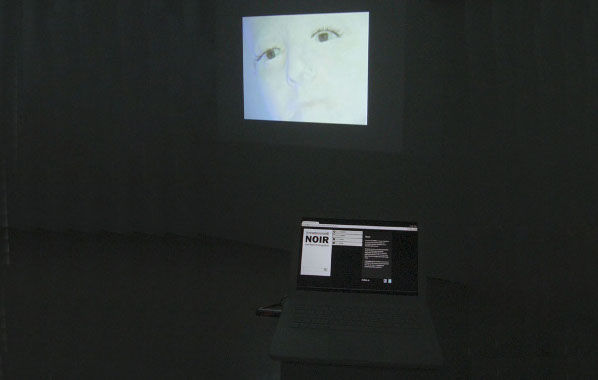
{crowdsourced} Noir / Love Beyond Recognition is a process-based artwork encompassing a sculptural installation and an interactive stream across the World Wide Web. The origin of both parts of the project is based upon the notion of ‘crowdsourcing’. The principle being that more heads are better than one. By canvassing a large crowd of people for ideas, skills, or participation, the quality of content and idea generation will be superior. In this instance, crowdsourcing will be applied through the use of clipsourcing tools which have been developed to aid in project-related tasks that can only be achieved through human interaction/intervention. This way, the crowd will help the artist achieve these tasks whilst adding a democratic element to the final outcome of the project.
During Spring and Summer 2012, an interested public was invited to both participate and contribute to the project’s creative process in two distinct ways: in Sweden as models, whereby a cast was taken of a chosen body part (the body parts were later assembled to full figure sculptures) and in the UK by taking part in a workshop at Furtherfield Gallery to help source short clips from the online public domain Film Noir Archive through our online tool.
The digital part of Posch’s project was developed in collaboration with UK artist and new media developer Mike Blackman.
Josefina Posch
Josefina Posch is a Swedish artist that has worked and exhibited extensively abroad, including at the 52nd Venice Biennale, Fondazione Pistoletto’s Cittadellarte, Sculpturespace NY and a residency at Duolun Museum of Modern Art Shanghai. During her 3 month residency at Art Space, Portsmouth, in Autumn 2010, she began her collaboration with artist and new media developer Mike Blackman in the development of her digital concepts.
The project is supported by Gothenburg City Arts Council, Arts Council England/British Council and IASPIS – The Swedish Arts Grants Committee’s International Programme for Visual Artists.
www.crowdsourcednoir.org
www.josefinaposch.com
Furtherfield Gallery
McKenzie Pavilion, Finsbury Park
London N4 2NQ
T: +44 (0)20 8802 2827
E: info@furtherfield.org
Furtherfield Gallery is supported by Haringey Council and Arts Council England.
ALL WELCOME
A project by Sarah Waterson and dogs (and their human companions) of Finsbury Park.
+ Dog walks: every Wed-Sat, between Wed 17 October and Fri 30 November 2012
Laika’s Dérive invites Finsbury Park’s dogs and their human companions to record a walk in their local park and surrounding area. This walk offers a chance for interspecies communication and a sharing of knowledge that results in a collaborative mapping of each dog/human’s walk.
Each dog is kitted-out with a system that automatically photographs the dog’s favourite vistas and objects on location. The photographs are selected via the sniff and interest time of the dog, and are returned to the human as a series of the dog’s favourite snaps, and displayed on Laika’s Dérive website.
Laika’s Dérive is part of the WWW: World Wild Web exhibition at Furtherfield Gallery.
To take your dog for a dérive, please contact Furtherfield Gallery at info@furtherfield.org or phone 0208 802 2827.
Walks can be booked by one person/dog Wednesday to Saturday between 1-5pm, from Wednesday 17 October to Friday 30 November 2012, so book early to avoid disappointment!
The kit collection point for the walk is Furtherfield Gallery, McKenzie Pavilion, in Finsbury Park.
Event Coordinator: Laura Bottin
Event Producer: Alessandra Scapin
Laika’s Dérive/Dog’s DeTour (2011) is a new media locative data-mapping work by Sarah Waterson about interspecies communication, collaboration and knowledge. Community participants and their dogs use an electronic mapping system (custom iphone app-GPS, accelerometer, interval timed and geo tagged photography) within their local area. The data collected is incorporated into the online mapping and visualisation system (website) together with the participant narrative and profiles. This work engages cross species sensing to explore a psychogeography of place.
A sketch for this project was produced during the Kiss Club incubator residency at the Performance Space, Carriageworks, Sydney. Feb 2010.(A minisite for the project prototype can be found here).
The android mobile phone application and harness system was developed during a residency at Blast Theory, UK, June- July 2011.
More info at http://laikasderive.sarahwaterson.net
Sarah Waterson
Sarah has practised as a new media artist for the past twenty years. Her works include electronic installations, collaborations with performers, video and audio work, generative and software based artworks, VR environments and data visualisations and ecologies. Interdisciplinary and collaborative practice informs the development and ultimately the design of these artworks. Her current interests include data mapping, data ecologies and cross species collaboration.
Sarah’s recent interactive installations have included: Laika’s Dérive (Performance Space, Carriageworks 2011), 33ºSouth (collaboration with Juan Francisco Salazar, Casula Powerhouse 2009), a custom made data mapping system that juxtaposes the cities of Sydney (Australia) and Santiago (Chile) trope, a e-literature project developed for the Second Life environment (SWF 08, ongoing), subscapePROOF (collaboration with Kate Richards, Australian Centre for the Moving Image, Melbourne), and subscapeBALTIC (ISEA2004, Helsinki, Finland). Sarah is a senior lecturer in interactive media at the School of Humanities and Communication Arts, University of Western Sydney, Australia.
Furtherfield Gallery is supported by Haringey Council and Arts Council England
FURTHERFIELD GALLERY OPENING HOURS
WWW: World Wild Web exhibition
18 October – 01 December 2012
Open Thu-Fri 1-5pm, Sat 11-5pm
Opening Event: Saturday 13 October 2012, 1-4pmFree admission to exhibition and events
Location
Furtherfield Gallery
McKenzie Pavilion, Finsbury Park
London N4 2NQ
T: +44 (0)20 8802 2827
E: info@furtherfield.org
Opening Event: Saturday 13 October 2012, 1-4pm
co-hosted with The Festival of Mint – A Celebration of Local Growing – serving mint tea and mojito
Contact: info@furtherfield.org
DOWNLOAD PRESS RELEASE FOR PRINT HERE
+ See images of the exhibition on Flickr.
To be alive is to be wild. And we humans have a will that shapes the world with language, song, lust, labour and play. And for those of us who connect with it, a network of machines now extends our reach, amplifies our urges and quickens our exchanges.
The artists in this exhibition work and play with living organisms and technical things, systems and language, to explore how our relation to the natural world is changing. They introduce us to the unruly life going on in other natural webs of communication, knowledge and feral exchange. Gallery visitors (humans and dogs) are invited to view videos, interact with art installations and social media and undertake walks in the surrounding park with its other animals and edible plants.
Mary Flanagan travels overland and undersea in virtual worlds. Her journeys in the worlds are caught on video. Her avatar scouts the boundary lines of ‘heritage’ landscapes built by “residents”. Her walks are inspired by Thoreau, the great American writer and walker, who knew that ‘all good things are wild and free’.
![Aquitaine from the [borders] series by Mary Flanagan](http://www.furtherfield.org/wp-content/uploads/2012/08/borders-acquitaine-web.jpg)
Andy Deck calls attention to echoes of the wild in language. Despite the many entertaining digital visions of nature beamed to the flat screen, a wealth of intuitions relating to nature still survive in colorful expressions passed down for centuries. He invites you to help him build a bestiary of animal idioms using social media and a gallery installation.*
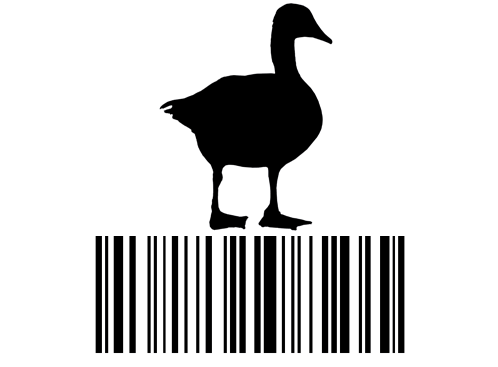
Sarah Waterson has invented a set of cartographic tools for dogs (and their human friends) to develop an interspecies psychogeography. Her electronic mapping system generates sniff data, routes and photographic journals supporting communication, collaboration and knowledge-sharing between companion species.
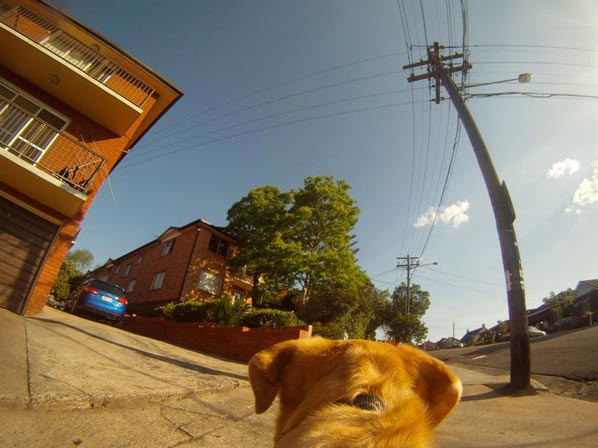
Helen Varley Jamieson and Paula Crutchlow dramatise the private actions and global consequences of our domestic lives in a long-running series of networked performances located in peoples’ homes. Dave’s Quiz (part 2) is an interactive extension of their provocation to discuss and appreciate relationships between personal, state and corporate responsibility around issues of consumption and disposal in late-capitalism.
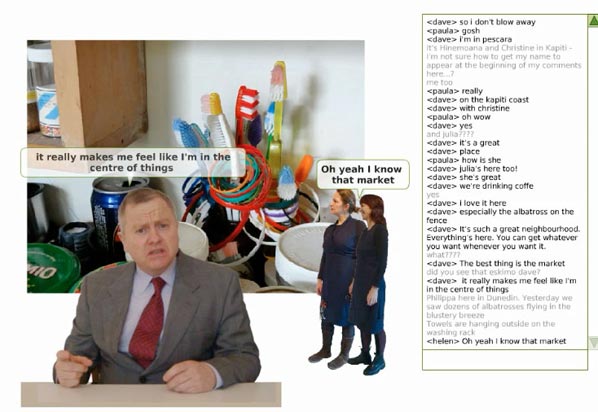
Artists duo Genetic Moo invite us to discover a dark, interactive sea of wiggling, luminescent creatures that gorge on torch light. They fantasize an evolutionary digression through the lens of human sensuality, drawing on images made by early scientists as they first found micro organisms or Animacules swarming in every sea, pond and pool of saliva.
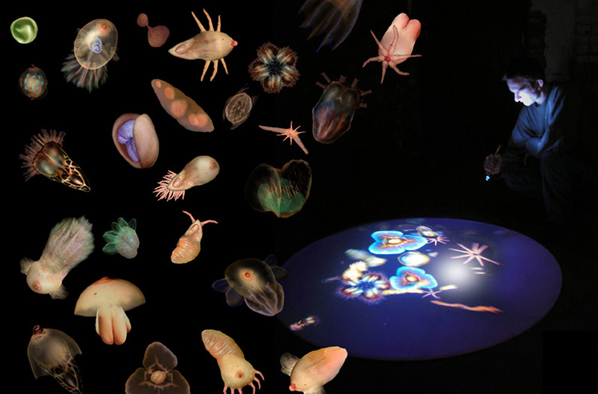
Disquieted by the environmental impact of constant technological upgrades, Dominic Smith works with open knowledge from the DIY mycology movement to create a system that combines the waste products from the tools and fuels of the contemporary coder. Out-of-date software manuals and coffee grounds are shredded to create a compost for fruiting oyster mushrooms to be harvested and consumed by visitors.**
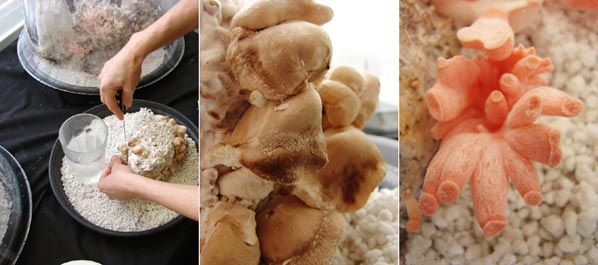
This exhibition is dedicated to Jay Griffiths, author of WILD: An Elemental Journey (2006).
* Crow_sourcing is a 2012 Commission of New Radio and Performing Arts, Inc. for its Turbulence website. It was made possible with funding from the Jerome Foundation. http://Turbulence.org/Works/crow_sourcing
** Dominic Smith developed this iteration of the shredder concept, originated by Julian Priest, David Merritt & Adam Hyde, as part of the geekosystem project. It is an experimental transposition of software development methods taking an organic, material form. It’s also worth noting that in his 1998 net art work Shredder 1.0 Mark Napier took the texts and images from pages of the WWW and jumbled them in colourful abstractions to reveal their ‘rawness’ once freed from the strict orthodoxies of web page design.
Crow_sourcing by Andy Deck
[borders] by Mary Flanagan
Animacules by Genetic Moo
make-shift: Dave’s quiz (part 2) by Helen Varley Jamieson & Paula Crutchlow
Shredder by Dominic Smith
Laika’s Dérive – The dogs de Tour by Sarah Waterson
Paula Crutchlow
Paula Crutchlow is a performance maker and director who co-authors live events across a variety of forms. As a co-founder and director of Blind Ditch she combines digital media and performance to engage audience and participants in distinct and active ways. Her work often uses a mix of score/script, improvisation and structured interaction to focus on boundaries between the public-private, and issues surrounding the construction of identity and the politics of place. Paula is currently the Creative Advisor for Adverse Camber directing work with some of the UK’s leading storytellers, she was an Associate Lecturer in Theatre at Dartington College of Arts, Devon 2001-10, and teaches Digital Performance Practice at the University of Plymouth.
Andy Deck
Andy Deck specializes in collaborative processes and electronic media. As a Net artist and software culture jammer, Deck combines code, text, and image, demonstrating patterns of participation and control that distinguish online presence and representation from previous artistic practices. In addition to numerous online exhibitions, his work has appeared in exhibitions like net_condition (ZKM), Unleashed Devices (Watermans Art Centre), and Animations (PS1-MoMA). He is also a co-founder of Transnational Temps, a media arts collective concerned with making Earth Art for the 21st Century.TM After showing in EcoMedia, a ground-breaking series of european exhibitions, Transnational Temps mounted the 2010 oil-related exhibition Spill>>Forward in New York. In 2011 Deck received first prize in the interactive division of the LÚMEN_EX Digital Art Awards. Deck’s work, currently shown by the Whitney Museum of American Art’s Artport and the Tate Online, has been commissioned by these and other prestigious institutions. Deck lives and works in New York City.
Mary Flanagan
Mary Flanagan is an artist focused on how people create and use technology. Her collection of over 20 major works range from game-inspired systems to computer viruses, embodied interfaces to interactive texts; these works are exhibited internationally at venues including the Laboral Art Center, The Whitney Museum of American Art, SIGGRAPH, Beall Center, The Banff Centre, The Moving Image Center, Steirischer Herbst, Ars Electronica, Artist’s Space, The Guggenheim Museum New York, Incheon Digital Arts Festival South Korea, Writing Machine Collective Hong Kong, Maryland Institute College of Art, and venues in Brazil, France, UK, Canada, Taiwan, New Zealand, and Australia. Her three books in English include Critical Play (2009) with MIT Press. Flanagan founded the Tiltfactor game research laboratory in 2003, where researchers create game interventions for social change.
Genetic Moo
Genetic Moo build living installations in pixels and light. The duo have been creating interactive art since 2008. Virtual creatures are constructed from choreographed video clips, combining elements of the human and the animal. They respond in a variety of life-like ways to audience motion, sound and touch and vary in size from the tiny Animacules to the all encompassing Mother. The works are driven using Open Source and Flash Software utilizing a variety of interactive interfaces. The programming behind the work is just complex enough to make the creatures appear more believable and create rich user driven narratives.
Schauerman and Pickup both gained Masters degrees from the Lansdown Centre of Electronic Arts. Their work has been exhibited extensively including the De La Warr Pavilion (2010); Watermans (2010) The Wellcome Collection (2011) and Glastonbury (2011). One of their works, Starfish, received a John Lansdown Award for Interactive Digital Art at Eurographics (2007) and was nominated for an Erotic Award (2012).
Helen Varley Jamieson
Helen Varley Jamieson is a writer, theatre practitioner and digital artist from New Zealand. In 2008 she completed a Master of Arts (research) at Queensland University of Technology (Australia) investigating her practice of cyberformance – live performance on the internet – which she has been developing for over a decade. She is a founding member of the globally-dispersed cyberformance troupe Avatar Body Collision, and the project manager of UpStage, an open source web-based platform for cyberformance. Using UpStage, she has co-curated online festivals involving artists and audiences around the world. Helen is also the “web queen” of the Magdalena Project, an international network of women in contemporary theatre.
Dominic Smith
Dominic Smith is an artist who engages with project hierarchy, ownership of ideas and heuristic curatorial strategies. Dominic is a founding member of ptechnic.org. He has exhibited and performed at Govett-Brewster Art Gallery in New Zealand, at the ICA in London, CCA Glasgow, AV Festival, Newcastle and Eyebeam NY. He has a doctorate with CRUMB at Sunderland University that examines the relationship between open source production methods, and art/curating methods. Dominic is also the current curator of thepixelpalace.org through which he also developed and runs basic.fm
Sarah Waterson
Sarah Waterson has practised as a new media artist for the past twenty years. Her works include electronic installations, collaborations with performers, video and audio work, generative and software based artworks, VR environments and data visualisations and ecologies. Interdisciplinary and collaborative practice informs the development and ultimately the design of these artworks. Her current interests include data mapping, data ecologies and cross species collaboration.
Sarah’s recent interactive installations have included: Laika’s Dérive (Performance Space, Carriageworks 2011), 33ºSouth (collaboration with Juan Francisco Salazar, Casula Powerhouse 2009), a custom made data mapping system that juxtaposes the cities of Sydney (Australia) and Santiago (Chile) trope, a e-literature project developed for the Second Life environment (SWF 08, ongoing), subscapePROOF (collaboration with Kate Richards, Australian Centre for the Moving Image, Melbourne), and subscapeBALTIC (ISEA2004, Helsinki, Finland). Sarah is a senior lecturer in interactive media at the School of Humanities and Communication Arts, University of Western Sydney, Australia.
Furtherfield Gallery
McKenzie Pavilion, Finsbury Park
London N4 2NQ
T: +44 (0)20 8802 2827
E: info@furtherfield.org
Furtherfield Gallery is supported by Haringey Council and Arts Council England
Part of Furtherfield Open Spots programme.
Please join us for a drop-in ‘clipsourcing’ workshop led by Swedish artist Josefina Posch in collaboration with artist and new media developer Mike Blackman (UK).
Using online tools specifically created for the project, participants will identify who the speakers are, contribute keywords, and rate short movie clips from the online public domain Film Noir Archive. The contribution will help shape the final interactive piece that will be streamed live at Futherfield Gallery in December 2012.
See images of the workshop on Flickr.
{crowdsourced} Noir / Love Beyond Recognition is a process-based artwork encompassing a sculptural installation and an interactive stream across the World Wide Web. The origin of both parts of the project is based upon the notion of ‘crowdsourcing’. The principle being that more heads are better than one. By canvassing a large crowd of people for ideas, skills, or participation, the quality of content and idea generation will be superior. In this instance, crowdsourcing will be applied through the use of clipsourcing tools which have been developed to aid in project-related tasks that can only be achieved through human interaction/intervention. This way, the crowd will help the artist achieve these tasks whilst adding a democratic element to the final outcome of the project.
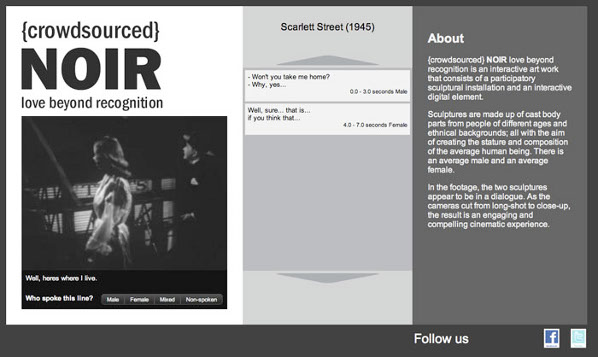
During Spring and Summer 2012, an interested public will be able to both participate and contribute to the project’s creative process in two distinct ways: in Sweden as models, whereby a cast will be taken of a chosen body part (the body parts will later be assembled to full figure sculptures) and in the UK by taking part in a workshop at Furtherfield Gallery to help source short clips from the Online Public Domain Film Noir Archive through our online tool. The final iteration of the project will be exhibited in Gothenburg, Sweden in December 2012 with live interactive streams at Furtherfield Gallery, London.
Josefina Posch
Josefina Posch is a Swedish artist that has worked and exhibited extensively abroad, including at the 52nd Venice Biennale, Fondazione Pistoletto’s Cittadellarte, Sculpturespace NY and a residency at Duolun Museum of Modern Art Shanghai. During her 3 month residency at Art Space, Portsmouth, in Autumn 2010, she began her collaboration with artist and new media developer Mike Blackman in the development of her digital concepts.
The project is supported by Arts Council England/British Council and the Gothenburg City Arts Council.
We are collecting childhood rhymes from around the world spoken by many generations of local residents of the borough for a sound installation as part of the Cultural Olympiad Festival.
Please come to Furtherfield Gallery in Finsbury Park on Saturday 21 July, 11-3pm to take part!
See images of the launch on Flickr.
Artist and composer Michael Szpakowski has worked with local children and their families to create a generative sound sculpture that invokes the collective memory of childhood, drawing on the memories of Haringey residents from all over the world.
A collective memory of childhood will be launched on Saturday 28 July 2012, 2-5pm.
To add your voice to this sound installation come to the gallery on Saturday 21 July between 11am and 3pm. You will meet the artist Michael Szpakowski who will be recording with you and other local residents any childhood rhymes, skipping songs or lullabies.
+ For more information please contact Ale Scapin
Michael Szpakowski is an artist, composer and film-maker who devises and facilitates many of our Outreach projects with young people. Participants create films, games and performances that explore the tools and processes of co-co-creation in a digitally connected world. The work engages young people, meeting them where they are in a constructive, imaginative and inclusive way. With DVcam in hand he finds poetry in the everyday, music in a London pavement and if called upon could find a way to inspire the imaginations of curbstones with his enthusiasm, experience and skill-sharing abilities.
www.somedancersandmusicians.com
Sign up: ale[at]furtherfield.org
See images of the walk on Flickr.
Public exploratory radiation walk around Finsbury Park, measuring mobile phone radiation levels and discovering what type of radiations we are exposed to on a daily basis. As we walk, we will unravel a parallel, hidden story of the local area along with technical data and possible medical effects of the radiation. Participants will measure radiation levels, GPS positions and marked levels on a large map of the area, creating a collaborative artwork (poster sized map of local radiation) to be made available for display as part of the exhibition after the event.
Participants are encouraged to listen to the sounds we will be hunting for (GSM, 3G, Tetra) here.
Dave Miller
Dave Miller is a South London based artist and currently a Research Fellow in Augmented Reality at the University of Bedfordshire. Through his art practice Dave draws out the invisible forces that make life difficult. His work is about caring and being angry, as an artist. His art enables him to express feelings about the world, to attempt to explain things in a meaningful, yet subjective way, and make complexed information accessible. Recurrent themes in his work are: human stories, injustices, contentious issues and campaigning. Recently he’s been very bothered by the financial crisis.
+ Finsbury Park Radiation Walk is part of Invisible Forces at Furtherfield Gallery.
+ More Invisible Forces events.
See images of the event on Flickr
Olga P Massanet and Thomas Aston have built a custom made VLF antenna to monitor ionospheric disturbances caused by solar storms. For this exhibition they invite makers and thinkers to participate in a creative sprint and come up with ideas on how to make these disturbances felt. Whether it’s a device, a visualisation, a sonification, or a poem, participants will design interfaces to tune into some of the most powerful forces that permeate our world.
In a matter of 5 hours participants will experience what the artists have been through in the past 5 months. In teams, they’ll get to build an antenna, tune it, collect the data and conceive or experiment with actual or possible interfaces to make solar storms ever more tangible!
Olga P Massanet
Olga is a media artist and researcher working as co-editor on the Furtherfield website and developing and delivering workshops for the Zero Dollar Laptop project and Furtherfield’s Outreach programme. Olga is currently pursuing a practice-based PhD at Goldsmiths. Her research project looks into assemblages of sunlight, human bodies and machines. She is particularly interested on subtle modes of communication across bodies of radically different nature. She looks at the ways in which electronic circuits, computational systems, endocrine processes and neurological happenings intermingle. The tools she develops are speculations about the undercurrents of body communication.
Thomas Cade Aston
Thomas is an emerging sound artist and electronic musician based out of London, UK and Toronto, Canada. His composition, production and performance work explores the dark and meditative fringes between technical, cerebral and somatic experience. Recent work includes ambient electronic compositions for Space Video (Turbulence/Revised Projects– Vancouver), an interactive soundscape for A Place to Reflect (Nuit Blanche-Toronto) and a highly anticipated electronic A/V performance at NewFormsFestival 11 (Vancouver). Thomas is busy at play in the spectrum, pursuing an MA in Interactive Media at Goldsmiths College, UK and readying for the launch of his debut LP Greenwich Mean Time with Hybridity Music this summer.
+ Technologies of Attunement is part of Invisible Forces at Furtherfield Gallery.
+ More Invisible Forces events.
3 Keys – The River Oracle by the Hexists is the opening act of the Moving Forest 12 hour performance.
+ Listen to the sounds of Act 0 ‘Omen’ for the Moving Forest London 2012
1. Introduction ‘Output 1’
2. Omen Section 1 ‘Output 3 and 4’
3. Omen Section 1 ‘Output 5’
+ And download the score for the Hackney Brook.
Cybernetic systems and game theory are about anticipating and influencing human behaviour using algorithmic code, databases, social media etc – the industries of data-mining, data profiling and data protection can be said to be the new ‘magic’ by which biopolitical control of our bodies and identities is maintained.
3 Keys – The River Oracle with The Hexists is a game of chance and divination in association with The Moving Forest, Act 0. It attempts to invoke the relationship between the divinatory functions of our contemporary ‘influencing machines’ (cybernetic systems and game theory using data-mining, data profiling and data protection) and traditional magical ones, creating new machines in the process. Using tools such as cards, dowsing, stick throwing to interpret phenomena in the landscape, historical and current, ‘readings’ can be cast, allowing associative action, language and thought to determine what might happen in the future, to create a path, an artwork.
In 3 Keys (version 3), participants will follow the Hackney Brook, an old subterranean river that begins near Finsbury Park and ends up in the River Lea near the site of the Olympics, using different exercises to interpret the landscape and cast readings. We will ‘mark’ the route along the way with objects and stories and other inscriptions. The river is the oracle and we are the transmisson. The documentation and divination tools will be made available for display in the exhibition after the event.
IMAGES FROM THE WALK ON FLICKR
Rachel Baker
(The Hexists)
Rachel Baker is a network artist who collaborated on the influential irational.org. Her art practice explores techniques used in contemporary marketing to gather and distribute data for the purposes of manipulation and propaganda. Networks of all kinds are “sites” for Baker’s public and private distributed art practice, including radio combined with Internet (Net.radio), mobile phones and SMS messaging, and rail networks.
Kayle Brandon
(The Hexists)
Kayle Brandon is a inter-disciplinary Artist/researcher, whose work is sited within the public, social realm. She predominantly works in collaborative and collective fields; a working method which informs much of her ethos around the making of art. Her main areas of interest are in the relationships between the natural and urban worlds and Human/Non-human relations. She investigates this field via physical intelligence, provocative intervention, observation, self-guided exploration and collective experiences.
First presented at Transmediale.08. Berlin 2008, Moving Forest London maps an imaginary castle and a camouflaged forest revolt onto the hyper-playground of the London metropolis on the eve of Olympics 2012. Presented by a temporarily assembled troupe AKA the castle, Moving Forest brings together diverse visual/sonic/electronic/digital/ performance artists along with writers, walkers, coders, hackers, mobile agents, twitters, networkers and the general public to realize a contemporary version of a classic play.
http://www.movingforest.net/
DOWNLOAD A PRESS RELEASE HERE
+ 3 Keys – The River Oracle is part of Invisible Forces at Furtherfield Gallery.
+ More Invisible Forces events.
Sign up: ale[at]furtherfield.org
Saturday 23 June 2012, 1-5pm
Summer Board Games and Picnic with Class Wargames and Kimathi Donkor
Join us for a day of debate around the leader of the Haitian Revolution, Toussaint Louverture, now regarded as an important icon of anti-slavery struggles. Class Wargames interviews the artist Kimathi Donkor who created the history painting Toussaint Louverture at Bedourete to mark 200 years since the independence of Haiti. The event will kick off with a picnic in the park and continue with an afternoon of collective playing of Guy Debord’s The Game of War, a Napoleonic-era military strategy game where armies must maintain their communications structure to survive – and where victory is achieved by smashing your opponent’s supply network rather than by taking their pieces.
In a short film by Ilze Black, Dr Richard Barbrook and Fabian Tompsett of Class Wargames interview Donkor about the work. Alex Verness from Class Wargames will be documenting the day by taking xenographs of participants.
IMAGES FROM THE TALK ON FLICKR
Saturday 30 June 2012, 1-5pm
Summer Board Games and Picnic with Class Wargames
Join us for a talk about gaming the 1791-1804 Haitian Revolution led by Richard Barbrook and Fabian Tompsett of Class Wargames. The event will kick off with a picnic in the park and continue with an afternoon of collective playing of Richard Borg’s Commands & Colors, a Napoleonic-era military strategy game.
IMAGES FROM THE EVENT ON FLICKR
Class Wargames
Class Wargames is an avant-garde movement of artists, activists, and theoreticians engaged in the production of works of ludic subversion in the bureaucratic society of controlled consumption.
The members of Class Wargames are Dr. Richard Barbrook, author and senior lecturer in the Department of Politics & IR at the University of Westminster; Rod Dickinson, artist and lecturer at University of the West of England; Alex Veness, artist and co-founder of Class Wargames;Ilze Black, media artist and producer; Fabian Tompsett, initiator of London Psychogeographical Association and author; Mark Copplestone, author and figure designer; Lucy Blake, Software developer; Stefan Lutschinger, lecturer, artist and researcher; and Elena Vorontsova, World Radio Network and journalist.
Kimathi Donkor
Kimathi Donkor lives and works in London. He attained his B.A. at Goldsmiths and an M.A. at Camberwell College of Art, both in Fine Art. In 2011 he received the Derek Hill Award painting scholarship for the British School at Rome; and, in 2010, his paintings were exhibited in the 29th São Paulo Biennial, Brazil.
+ Summer Board Games and Picnic is part of Invisible Forces at Furtherfield Gallery.
+ More Invisible Forces events.
As part of the Being Social exhibition at Furtherfield Gallery in Spring 2012, Ele Carpenter and Emilie Giles facilitated embroidery sessions with gallery visitors who stitched a term from the Raqs Media Collective’s text ‘A Concise Lexicon of/for the Digital Commons’ (2003).
View images from the workshops
The Embroidered Digital Commons is a collectively stitched version of ‘A Concise Lexicon of/for the Digital Commons’ by the Raqs Media Collective (2003). The project seeks to hand-embroider the whole lexicon, term by term, through workshops and events as a practical way of close-reading and discussing the text and its current meaning.
Crafters, programmers, artists, makers, and people interested in working collaboratively, or taking part in participatory projects gathered to each stitch a few words of the term meme, as described below. The resulting patches will be turned into a short film depicting the sequence of embroideries.

In 2003 the Raqs Media Collective wrote ‘A Concise Lexicon of/for the Digital Commons’. The full lexicon is an A-Z of the interrelationship between social, digital and material space. It weaves together an evolving language of the commons that is both poetic and informative. The terms of the lexicon are: Access, Bandwidth, Code, Data, Ensemble, Fractal, Gift, Heterogeneous, Iteration, Kernal, Liminal, Meme, Nodes, Orbit, Portability, Quotidian, Rescension, Site, Tools, Ubiquity, Vector, Web, Xenophilly, Yarn, and Zone.
The concept of the digital commons is based on the potential for everything that is digital to be common to all. Like common grazing land, this can mean commonly owned, commonly accessed or commonly available. But all of these blurred positions of status and ownership have complex repercussions in the field of intellectual property and copyright. The commons has become synonymous with digital media through the discourse surrounding free and open source software and creative commons licensing. The digital commons is a response to the inherent ‘copy n paste’ reproducibility of digital data, and the cultural forms that they support. Instead of trying to restrict access, the digital commons invite open participation in the production of ideas and culture. Where culture is not something you buy, but something you do.
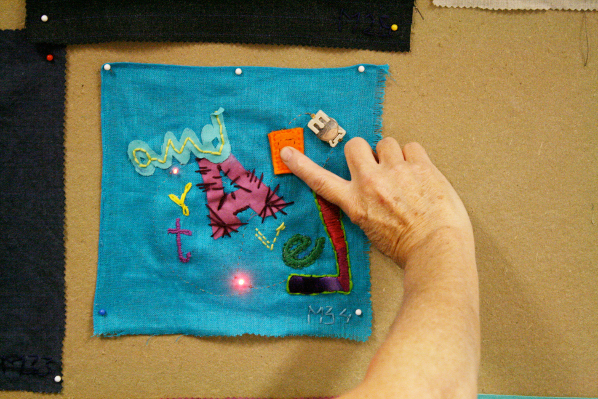
MEME
“Meme: The life form of ideas. A bad idea is a dead meme. The transience as well as the spread of ideas can be attributed to the fact that they replicate, reproduce and proliferate at high speed. Ideas, in their infectious state, are memes. Memes may be likened to those images, thoughts and ways of doing or understanding things that attach themselves, like viruses, to events, memories and experiences, often without their host or vehicle being fully aware of the fact that they are providing a location and transport to a meme. The ideas that can survive and be fertile on the harshest terrain tend to do so, because they are ready to allow for replicas of themselves, or permit frequent and far-reaching borrowals of their elements in combination with material taken from other memes. If sufficient new memes enter a system of signs, they can radically alter what is being signified. Cities are both breeding grounds and terminal wards for memes. To be a meme is a condition that every work with images and sounds could aspire towards, if it wanted to be infectious, and travel. Dispersal and infection are the key to the survival of any idea. A work with images, sounds and texts, needs to be portable and vulnerable, not static and immune, in order to be alive. It must be easy to take apart and assemble, it must be easy to translate, but difficult to paraphrase, and easy to gift. A dead meme is a bad idea.”

Ele Carpenter
Ele Carpenter is a curator based in London. Her creative and curatorial practice investigates specific socio-political cultural contexts in collaboration with artists, makers, amateurs and experts. She is a lecturer in Curating at Goldsmiths College, University of London.
Since 2005 Ele has facilitated the Open Source Embroidery project using embroidery and code as a tool to investigate the language and ethics of participatory production and distribution. The Open Source Embroidery exhibition (Furtherfield, 2008; BildMuseet Umeå Sweden, 2009; Museum of Craft and Folk Art, San Francisco, 2010) presented work by over 30 artists, including the finished Html Patchwork now on display at the National Museum of Computing at Bletchley Park. Ele is currently facilitating the ‘Embroidered Digital Commons’ a distributed embroidery exploring collective work and ownership 2008 – 2013.
Emilie Giles
Emilie Giles is an alumnus of MA Interactive Media: Critical Theory and Practice at Goldsmiths College. Since graduating in 2010 her time has been spent co-organising MzTEK, a women’s technology and arts collective, as well as completing an internship with arts group Blast Theory and working for social video distributors Unruly. She is currently involved with TESTIMONIES, a project which explores oral history in relation to the 2012 Olympic and Paralympic Games largely through social media.
Emilie’s own practice revolves around notions of pervasive gaming, married with urban exploration and psychogeography. Her most recent focus lies in taking fundamental gaming principles from Geocaching and exploring the consequences of adding an emotional dimension.
Sign up: ale[at]furtherfield.org
To accompany Invisible Forces, Furtherfield invites all gallery visitors to take part in a programme of public play, games, making and discussion led by alert and energetic artists, techies, makers and thinkers: Class Wargames, The Hexists, Dave Miller, Olga P Massanet and Thomas Aston.
Saturday 23 June 2012 – 1-5pm
Summer Board Games and Picnic with Class Wargames and Kimathi Donkor
Saturday 30 June 2012 – 1-5pm
Summer Board Games and Picnic with Class Wargames
Wednesday 04 July 2012 – 9-11am
3 Keys – The River Oracle – The Hexists
as part of Moving Forest by AKA The Castle
Wednesday 11 July 2012 – 11-5pm
Technologies of Attunement – Olga P Massanet and Thomas Cade Aston
Saturday 21 July 2012 – 2-5pm
Dave Miller’s Finsbury Park Radiation Walk
Contact: info@furtherfield.org
DOWNLOAD FULL PRESS RELEASE HERE
See images from the opening of Invisible Forces on Flickr.
Scroll down for the video of the exhibition.
An exhibition about why contemporary life is so difficult for so many
Invisible Forces features the work of artist-visionaries: Kimathi Donkor, Laura Oldfield Ford, IOCOSE, Dave Miller, Edward Picot, and YoHa with additional game events, talks and workshops with Class Wargames, The Hexists, Olga P Massanet and Thomas Cade Aston.
Our social, economic and cultural institutions are being dismantled. Control over the provision of social care, urban and rural development, and education is being ceded to the market facilitated by unseen technological and bureaucratic systems.
Undeterred, the artists in this exhibition meet the challenges that ensue with clear eyes, spontaneity, experimentation and a sense of adventure. This selection of installations, digital video, net art, painting and drawings deal with conspiracy, money, politics and hidden signals.
As part of Invisible Airs, YoHa (Graham Harwood & Matsuko Yokokoji) attempted to read 20,000 comma separated lines of Bristol City Council’s apparently open-data. After which they understood that power reveals itself through multiple layers of boredom. They constructed four pneumatic contraptions which reveal the relations contained within the fields and the people affected. A video made by Alistair Oldham documents their art project Invisible Airs, Database, Expenditure & Power. Invisible Airs was commissioned by The University of the West of England’s Digital Cultures Research Centre (DCRC) in collaboration with the Bristol City Council’s B Open data project.
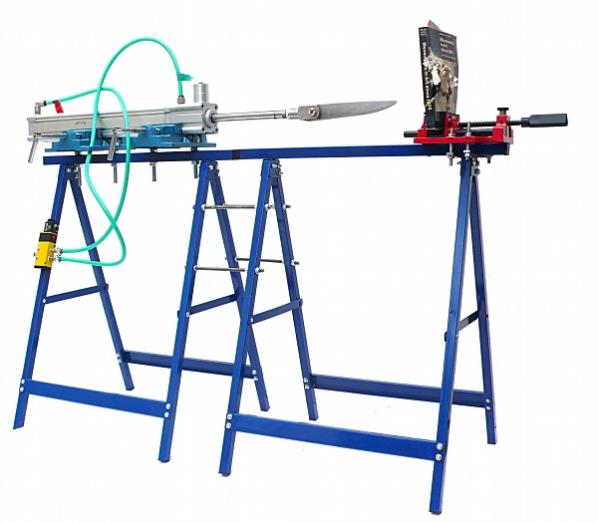
This is shown alongside Data Entry, a video that investigates how databases operate on us and through us by looking at the work of midwives and women in labour. “Databases move through us, allowing new forms of power to emerge… [they] order, compare, sort and create new views of the information they contain. New perspectives amplify, speed-up and restructure particular forms of power as they supersede others.”
Edward Picot is an artist and writer who also works as an administrator in the UK health service. His seriously funny soap-gone-wrong, Dr Hairy In…, chronicles the trials, tribulations and cogitations of an ordinary (but slightly hirsute) general practitioner – with hilarious results!* Dr Hairy’s struggles with NHS bureaucracy are brought to life in a series of satirical video shorts, featuring puppetry performances given by a child’s doll and screened in a doctor’s waiting room, as an installation. “It was like watching Team America set in the NHS” says Ian Hislop (broadcaster, editor of Private Eye and NHS patient).
Kimathi Donkor‘s Toussaint Louverture at Bedourete is a history painting made with oils on canvas that depicts an icon of anti-slavery struggles who, in his lifetime, was smeared as a reprehensible war lord. Created to mark 200 years since the independence of Haiti, the image shows the leader of the Haitian 1791-1804 revolution in a pose reminiscent of the Jacques Louis David’s Napoleon Crossing the Alps, surrounded by inspired revolutionaries in a battle that led to the creation of Haiti as the first slave free nation in history. In a short film by Ilze Black, Dr Richard Barbrook and Fabian Tompsett of Class Wargames interview Donkor about the work.
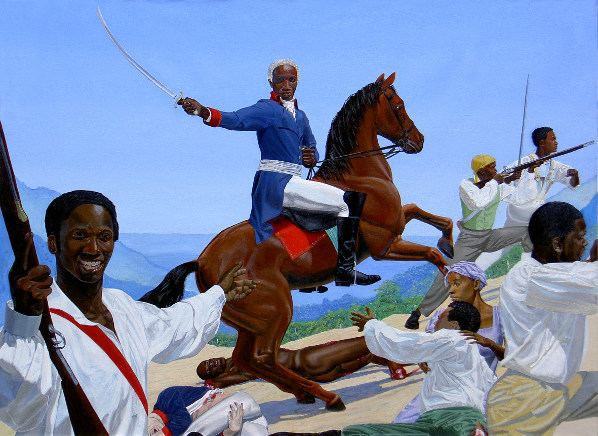
Laura Oldfield Ford‘s recent drawings are the result of walks (or ‘Drifts) through deserted urban spaces in the part of East London being prepared for the 2012 Games. They depict layers of failed utopias of the past and present and imagined futures. Known for her poetic and politically tuned ink drawings produced in print and online in her zine Savage Messiah, Oldfield Ford documents her psychogeographic explorations, in text and image, of the city as a site of social conflict, melancholy and political resistance.

Net artist Dave Miller presents two agitprop posters and a pamphlet of images reproduced from his interactive, multi-layered, online narrative bankers_bonuses. Miller worked with software he created himself to combine hand drawn illustrations with images gathered from Internet searches, and provocative (sometimes preposterous) statements made by powerful people about the ethical questions arising from the economic crisis.
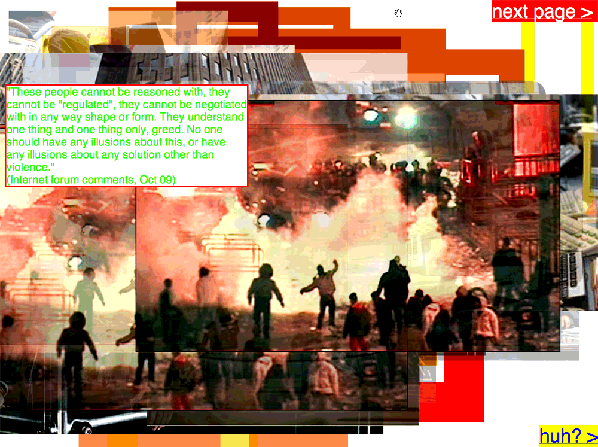
Italian artist group IOCOSE has created A Crowded Apocalypse, a net art project that exploits crowd sourcing tools in order to simulate a global conspiracy. The “crowd” assembles its own conspiracy and then protests against its protagonists and effects. A Crowded Apocalypse is commissioned by AND Festival and Furtherfield.
As we scan our cultures for maps, role-models, possible ways of living in today’s world, we often encounter images of society that are created by its hidden, controlling forces. By naming, revealing, tracking, playing, making, subverting and transforming tools, circumstances and figures that give rise to current crises we enlarge the debate and extend our freedoms. And the artists in this exhibition offer examples of just some of the ways in which this might be done.
* Important note. Dr Hairy In… is NOT a critique of socialised medicine and so we include a disclaimer: “The creators of this piece would like to point out that they all work in the National Health Service and are completely devoted to it.”
Free public play, games, making and discussion run alongside the exhibition.
Led by Dave Miller, The Hexists, Class Wargames, Olga P Massanet and Thomas Cade Aston. See HERE for details.
Rachel Baker (The Hexists)
Rachel Baker is a network artist who collaborated on the influential irational.org. Her art practice explores techniques used in contemporary marketing to gather and distribute data for the purposes of manipulation and propaganda. Networks of all kinds are “sites” for Baker’s public and private distributed art practice, including radio combined with Internet (Net.radio), mobile phones and SMS messaging, and rail networks.
Kayle Brandon (The Hexists)
Kayle Brandon is a inter-disciplinary Artist/researcher, whose work is sited within the public, social realm. She predominantly works in collaborative and collective fields; a working method which informs much of her ethos around the making of art. Her main areas of interest are in the relationships between the natural and urban worlds and Human/Non-human relations. She investigates this field via physical intelligence, provocative intervention, observation, self-guided exploration and collective experiences.
Class Wargames
Class Wargames is an avant-garde movement of artists, activists, and theoreticians engaged in the production of works of ludic subversion in the bureaucratic society of controlled consumption.
The members of Class Wargames are Dr. Richard Barbrook, author and senior lecturer in the Department of Politics & IR at the University of Westminster; Rod Dickinson, artist and lecturer at University of the West of England; Alex Veness, artist and co-founder of Class Wargames;Ilze Black, media artist and producer; Fabian Tompsett, initiator of London Psychogeographical Association and author; Mark Copplestone, author and figure designer; Lucy Blake, Software developer; Stefan Lutschinger, lecturer, artist and researcher; and Elena Vorontsova, World Radio Network and journalist.
Kimathi Donkor
Kimathi Donkor lives and works in London. He attained his B.A. at Goldsmiths and an M.A. at Camberwell College of Art, both in Fine Art. In 2011 he received the Derek Hill Award painting scholarship for the British School at Rome; and, in 2010, his paintings were exhibited in the 29th São Paulo Biennial, Brazil.
IOCOSE
IOCOSE has been working in Italy and Europe since 2006. It organises actions in order to subvert ideologies, practices and processes of identification and production of meanings. It uses pranks and hoaxes as tactical means, as joyful and sound tools. IOCOSE thinks about the streets, Internet and word of mouth as a battlefield. Tactics such as mimesis and trickery are used to lead and delude the audience into a semantic pitfall.
Dave Miller
Dave Miller is a South London based artist and currently a Research Fellow in Augmented Reality at the University of Bedfordshire. Through his art practice Dave draws out the invisible forces that make life difficult. His work is about caring and being angry, as an artist. His art enables him to express feelings about the world, to attempt to explain things in a meaningful, yet subjective way, and make complexed information accessible. Recurrent themes in his work are: human stories, injustices, contentious issues and campaigning. Recently he’s been very bothered by the financial crisis.
Laura Oldfield Ford
Laura Oldfield Ford lives and works in London. She studied at the Slade School of Art and completed her MA Painting at the Royal College of Art. She has exhibited extensively including Rokeby and Hales galleries in London, Savage Messiah takes over Late at Tate Britain, The Arnolfini, Bristol , De Appel Amsterdam and the Goethe Institute, New York. She has also recently been commissioned by Art Review. She is currently working on new projects for the Shenzhen Sculpture Biennial in China, the 2012 Gwangju Biennial and the show ‘Desire Paths’ at the Caja Madrid in Barcelona. A compilation of her zine ‘Savage Messiah’, which documents her psychogeographic drifts through London, is available on Verso books.
Edward Picot
Edward Picot was born in 1958. He lives in Kent with his dog, wife and daughter, not necessarily in that order. He earns his living as a Practice Manager in a doctor’s surgery, and in his spare time he does creative things – usually at the low-tech end of the new media spectrum. He started the Dr Hairy series – humorous short puppet-videos about a fictional doctor, closely based on his own experiences of working in the NHS – in 2010.
YoHa
Graham Harwood and Matsuko Yokokoji (YoHa – English translation ‘aftermath’) have lived and worked together since 1994.
YoHa’s graphic vision, technical tinkering, has powered several celebrated collaborations establishing an international reputation for pioneering critical arts projects.
Harwood and Yokokoji’s co founded the artists group Mongrel (1996-2007) and established the MediaShed a free media lab (2005-2008). In 2008 they joined Richard Wright to produce Tantalum Memorial shown in 9 countries and 15 cities over 4 years. In 2010 YoHa produced Coal Fired Computers before embarking on a series of works about the lived logics of database machinery including Invisible Airs, Data Entry in 2011 and Endless War in 2012.
Furtherfield Gallery
McKenzie Pavilion, Finsbury Park
London N4 2NQ
T: +44 (0)20 8802 2827
E: info@furtherfield.org
Furtherfield Gallery is supported by Haringey Council and Arts Council England
Dave Miller’s bankers_bonuses is supported by KAY MOUNTING.
Featured image: ‘Angry Women’ by Annie Abrahams, 2011. (From photograph by Michael Szpakowski)
Opening Event: Saturday 25 February 2012, 1-4pm
Open Thu – Sat 12 noon – 3pm
contact: info@furtherfield.org
See images from the exhibition here
Read reviews of Being Social on Wired magazine and Enfield Independent
Being Social is the opening exhibition at Furtherfield Gallery in Finsbury Park in North London. Furtherfield has established an international reputation as London’s first gallery for networked media art since 2004. With this exciting move to a more public space Furtherfield invites artists and techies – amateurs, professionals, celebrated stars and private enthusiasts – to engage with local and global, everyday and epic themes in a process of imaginative exchange.

This exhibition brings together artworks by emerging and internationally acclaimed artists: Annie Abrahams, Karen Blissett, Ele Carpenter, Emilie Giles, moddr_ , Liz Sterry and Thomson and Craighead.
Since the mid-90s computers have changed our way of being together. First the Internet then mobile networks have grown as cultural spaces for interaction – wild and banal, bureaucratic and controlling – producing new ways of ‘being social’. Visitors are invited to view art installations, software art, networked performances and to get involved with creative activities to explore how our lives – personal and political – are being shaped by digital technologies.
Free activities for all ages (booking advisable) Saturday 10-1pm
Embroidered Digital Commons with Ele Carpenter and Emilie Giles
Furtherfield invites all gallery visitors to take part in one or more of our Saturday morning embroidery sessions and come together to stitch a term from the Raqs Media Collective’s text ‘A Concise Lexicon of/for the Digital Commons’ (2003), chosen in relation to the specific theme of the Being Social exhibition at Furtherfield Gallery. Throughout March and April 2012.
To book a place please contact Alessandra Scapin ale@furtherfield.org +44 (0) 2088022827

Annie Abrahams
Annie Abrahams has a doctorate in biology from the University of Utrecht and a degree from the Academy of Fine Arts of Arnhem. In her work, using video, performance as well as the internet, she questions the possibilities and the limits of communication in general and more specifically investigates its modes under networked conditions. She is an internationally regarded pioneer of networked performance art. She has performed and shown work extensively in France, including at the Pompidou Centre, Paris, and in many international galleries including, among others, Espai d’Art Contemporani de Castelló, Spain; the Museum of Contemporary Art, Tokyo; and the Armenian Center for Contemporary Experimental Art, Yerevan; festivals such as the Moscow Film Festival and the International Film Festival of Rotterdam, and on online platforms such as Rhizome.org and Turbulence.
Karen Blissett
Karen Blissett was born on the 3rd of May 1991, on the same day that the first successful double head-heart transplant was being carried out in a hospital in London. Her parents are the neoist artists Karen Eliot and Luther Blissett. They are only interested in art and politics, not in how Karen spends her days on the Internet.
Ele Carpenter
Ele Carpenter is a curator based in London. Her creative and curatorial practice investigates specific socio-political cultural contexts in collaboration with artists, makers, amateurs and experts. She is a lecturer in Curating at Goldsmiths College, University of London.
Since 2005 Ele has facilitated the Open Source Embroidery project using embroidery and code as a tool to investigate the language and ethics of participatory production and distribution. The Open Source Embroidery exhibition (Furtherfield, 2008; BildMuseet Umeå Sweden, 2009; Museum of Craft and Folk Art, San Francisco, 2010) presented work by over 30 artists, including the finished Html Patchwork now on display at the National Museum of Computing at Bletchley Park. Ele is currently facilitating the ‘Embroidered Digital Commons’ a distributed embroidery exploring collective work and ownership 2008 – 2013.
Emilie Giles
Emilie Giles is an alumnus of MA Interactive Media: Critical Theory and Practice at Goldsmiths College. Since graduating in 2010 her time has been spent co-organising MzTEK, a women’s technology and arts collective, as well as completing an internship with arts group Blast Theory and working for social video distributors Unruly. She is currently involved with TESTIMONIES, a project which explores oral history in relation to the 2012 Olympic and Paralympic Games largely through social media.
Emilie’s own practice revolves around notions of pervasive gaming, married with urban exploration and psychogeography. Her most recent focus lies in taking fundamental gaming principles from Geocaching and exploring the consequences of adding an emotional dimension.
moddr_
moddr_ is a Rotterdam-based media/hacker/co-working space and DIY/FOSS/OSHW fablab for artgeeks, part of the venue WORM: Institute for Avantgardistic Recreation. Since being founded in 2007 by alumni of the Piet Zwart Institute (department of “Networked Media“) they host and promote young local and international talent with a focus on the artistic modification (’modding‘) of contemporary and emerging technology. moddr_ represents a critical attitude in our ‘new’-medialandscape through spawning and development of artistic projects, workshop series, lectures, exhibitions and of course good parties.
Liz Sterry
Liz Sterry is an Essex based artist currently completing a Digital Art and Design degree at Writtle College. Liz works using different mediums including performance photography, video and installations. Communication has now become a key theme in her work. She aspires to make art that invites people to question what they think they already know.
Thomson and Craighead
Jon Thomson and Alison Craighead are artists living and working in London. They make artworks and installations which are shown in galleries, online and sometimes outdoors. Much of their recent work looks at live networks like the web and how they are changing the way we all understand the world around us. Their work has been shown in major international exhibitions and is part of public collections at Harris Museum and British Council Collection. They are shortlisted artists for the Samsung Art Prize 2012. Recent awards include Current (2011) and Vital Spark (2005). Having both studied at Duncan of Jordanstone College of Art in Dundee, Jon now lectures part time at The Slade School of Fine Art, University College London, while Alison is a senior researcher at University of Westminster and lectures in Fine Art at Goldsmiths University.
Four spaces – the Park, the Gallery, the Common Room, the www
Furtherfield’s new gallery at McKenzie Pavilion is located in a highly animated area of Finsbury Park next to a boating pond and adventure playground, near to the café and athletics track. The richly connected diversity of people, creatures, plants, activities, enthusiasms alive in the park provides the context and the inspiration for Furtherfield. The pavilion has two rooms.
The Gallery, which will display evocative and provocative exhibitions of selected contemporary artwork that address technology and social change drawing on Furtherfield’s international network of artists.
The Common Room, which will display work contributed by open call in response to exhibition themes, curated with local people. It will also act as the base for a series of free activities for local schools and visitors to the park.
Finally the www connects local users to an international network of enthusiasts, experts and audiences. It provides a place for people to share their artworks, proposals, ideas and commentaries. It will also provide access to further information about exhibitions, including downloadable catalogues and essays, information about programmes of free events and activities, and a living archive of all past work.
Furtherfield will exhibit the best of contemporary work in art, technology and social change in a truly ‘public’ space, developed with and for local residents and users of the park, and wider participants and audiences. Ultimately, we are looking for ways for local people and visitors to the park and from further afield to use this art space imaginatively together, and to connect with our international community of artists, designers, thinkers and technologists.
Furtherfield Gallery
McKenzie Pavilion, Finsbury Park
London N4 2NQ
T: +44 (0)20 8802 2827
E: info@furtherfield.org
Furtherfield Gallery is supported by Haringey Council and Arts Council England
In February 2012 Furtherfield is opening a public gallery at McKenzie Pavilion in Finsbury Park, providing space for exhibitions, activities and events for art, technology and social change. Before we officially open we would like to invite local community groups and organisations to join us in a friendly networking event which we hope will be the first of many, leading to fruitful partnerships and collaborations.
Inviting Local community groups!
During the event, you will…
– Meet up, be seen, show what you do
– Get to know other organisations and discuss ways we can collaborate
– Inform Furtherfield as to what can happen in the space
We are living through times of great change and uncertainty. Over the next 18 months, Furtherfield hopes to provide a space for imaginative exchange between artists – international and local, of all ages and backgrounds – on epic and everyday themes. Our success depends on the quality of our conversations. We hope that this event will be the first of many that will lead to fruitful partnerships and collaborations. We are inviting local organisations and groups involved in the arts, education, community engagement and support, and all of those working in and running activities in the park.
A full list of confirmed guests will be made available at the event. Please tell us about people or organisations who are important to our area and or who might want to come along and get involved.
Refreshments will be provided.
Please RSVP to Alessandra Scapin, Furtherfield Programme Manager and Coordinator, on ale[at]furtherfield.org to confirm your attendance as the pavilion has limited capacity or on 020 8802 2827 (please leave a message – we are not always in the office)
For more information about getting to the gallery http://www.furtherfield.org/gallery/visit
Furtherfield presents Moving Forest 500 Slogans workshop at Victoria & Albert Museum.
Join AKA the Castle for up to 5 slogan workshop sessions, December 2nd-4th at the V&A, as part of Moving Forest London 2012 initiative.
The Moving Forest 500 slogans workshop invites writers, artists, performers, theatre practitioners, soundists, noisers, singers (of all genres), scholars and folks to come together to contribute their readings of the 500 slogans written by Dr Matthew Fuller alongside Graham Harwood’s 12 hour rendering of the final 12 minutes of Kurosawa’s film version of Macbeth, Spider Web Castle.
Read, recite, sing, shout, scream, murmur, memorize and burn the slogans and plot the 500 slogans as the main thread through the 5 acts of MOVING FOREST.
Moving Forest is a 12 hour, five act, visual, sonic, digital, electronic and urban performance collectively realized by AKA the Castle, a temporal performance troupe bringing together visual artists, writers, soundists, silk threaders, codedecoders, macromikro, boombox mass, mobile agents, wifi fielders and urbanites. 12 hours of sonic, coded action map an imaginary Castle and camouflage forest revolt onto a given modern day metropolis.
We welcome public participation in Moving Forest 500 slogans workshops.
By participating, you join AKA the Castle’s collective reading and planning towards staging Moving Forest 12 hour performance in London summer 2012.
Please sign up below to take part in one or more workshop sessions.
Friday 02 December, 6-9pm
Saturday 03 December, 11-1pm
Saturday 03 December, 2-4:30pm
Sunday 04 December, 11-1pm
Sunday 04 December, 2-4:30pm
All workshops will take place in Seminar Room 1, Sackler Centre, V&A.
To sign up to one or more sessions please write to now@movingforest.net
or select your session on the 500 slogans wiki
http://scrying.org/doku.php?id=500slogans
Free workshop admission.
Victoria and Albert Museum
Seminar Room 1, Sackler Centre
Cromwell Road, London SW7 2RL
http://www.vam.ac.uk/
Additional workshop activity at SPACE as part of Moving Forest London 2012 initiative
More info: http://spacestudios.org.uk/whats-on/events-projects/moving-forest-pd-pure-data-workshop
More information about Moving Forest:
http://www.movingforest.net
http://movingforest.net/html/slogans.html
The partners for Moving Forest London workshop development are MA Interactive Media & Centre for Cultural Studies at Goldsmiths University of London, Furtherfield, SPACE, Digital Programmes,V&A.
AKA the Castle
Strategy workshops: How Can A Forest Move?
Part of Moving Forest London2012 development workshops
All events are free but space is limited.
Booking essential. Please RSVP to now@movingforest.net
Friday 9 December 2011, 11-4pm. Furtherfield Gallery
Isaac Marrero-Guillamón – The Militant City
Saturday 10 December 2011, 11-4pm. Furtherfield Gallery
Rachel Baker and Kayle Brandon – The Witches and 3-Keys
Monday 12 December 2011, 6-9pm. Furtherfield at SPACE MediaLab
The Laboratory of Insurrectionary Imagination presents:
TREE THOUGHTS: Strategies of artivisme and permaculture, a taster
Furtherfield Gallery, McKenzie Pavilion, Finsbury Park, London N4 2NQ
Friday 9 December 2011, 11-4pm
The Olympic mega-event is akin to Rancière’s ‘order of the police’. It regulates what is visible and invisible, sayable and unsayable, thinkable and unthinkable; it distributes individuals and groups in positions of ruler or ruled.” Join Isaac Marrero-Guillamón, researcher for The Militant City, in a discussion and workshop on exploring the role of art in relation to the Olympics, its legal architecture, and its elevation to a ‘state of exception’. Bring projects, ideas, stories and prepare for battle over the control of language, sign, transmission and public space.
Furtherfield Gallery, McKenzie Pavilion, Finsbury Park, London N4 2NQ
Saturday 10 December 2011, 11-4pm
Rachel Baker and Kayle Brandon jointly lead this day of prophecy, prediction and mobilization strategies for mapping the Moving Forest onto the London Olympics; tuning in the camouflaged branches to the contemporary mood of economic chaos and revolt.
Rachel Baker – Witches, Prophecy and Prediction
The story of Macbeth began with a witches’ prophecy and ended in murder and revolt. Did the witches predict a future already seen or did they merely plant some well-placed psychological seeds to trigger a self-fulfilling prophecy? In doing so, were they able to influence reality? What prior information did they need to have? Is it the magical, spectral appearance of the witch that lends the prophecy its power, or their insertion into everyday life?
Kayle Brandon- 3-Keys
The three witches’ prophecy and their tools and techniques of divination are deployed to make a card game called The 3-Keys. Illuminating insurgent mobilisation strategies, the game will map the key relational powers within the Olympic game, matching/twinning them with the essential Macbeth elemental and physical conditions. Discussion will surround further oracle, divination tools and techniques that enable one’s actions to be fated or influenced by these processes.
The Laboratory of Insurrectionary Imagination presents:
Furtherfield at SPACE MediaLab
, 129—131 Mare Street, London E8 3RH, 020 8525 4330
Monday 12 December 2011, 6-9pm
This workshop is a taster to methodologies that merge ecological design models of Permaculture with forms of creative resistance. Permaculture mimics the patterns of living systems and applies them to human designs, these whole system thinking tools will be applied to strategies for developing creative actions. The workshop is suitable for artists and activists of all sorts and with any kind of experience and aims to give a feel of how it might be to “think like a forest”.

The workshops are in preparation for a performance of Moving Forest, first presented at Transmediale.08 in Berlin, during London Olympics 2012 by AKA the Castle in partnership with MA Interactive Media & Centre for Cultural Studies at Goldsmiths, University of London, Furtherfield, Space, MzTEK, Digital Programmes and Victoria and Albert Museum.
A 12 hour, five act, visual, sonic, digital, electronic and urban performance collectively realized by AKA the Castle, a temporal performance troupe bringing together visual artists, writers, soundists, silk threaders, codedecoders, macromikro, boombox mass, mobile agents, wifi fielders and urbanites. 12 hours of sonic, coded action map an imaginary Castle and camouflage forest revolt onto a given modern day metropolis.
Isaac Marrero-Guillamón
Isaac Marrero-Guillamón is a sociologist/anthropologist. He has lived and worked in London since 2007. He is currently a post-doctoral research fellow at Birkbeck, University of London, undertaking a two-year project called The Militant City, which investigates artistic practices critical towards the Olympics.
Rachel Baker
Rachel Baker is a network artist who collaborated on the influential irational.org. Her art practice explores techniques used in contemporary marketing to gather and distribute data for the purposes of manipulation and propaganda. Networks of all kinds are “sites” for Baker’s public and private distributed art practice, including radio combined with Internet (Net.radio), mobile phones and SMS messaging, and rail networks.
Kayle Brandon
Kayle Brandon is a inter-disciplinary Artist/researcher, whose work is sited within the public, social realm. She predominantly works in collaborative and collective fields; a working method which informs much of her ethos around the making of art. Her main areas of interest are in the relationships between the natural and urban worlds and Human/Non-human relations. She investigates this field via physical intelligence, provocative intervention, observation, self-guided exploration and collective experiences.
The Laboratory of Insurrectionary Imagination
Infamous for fermenting mass disobedience on bicycles during the Copenhagen climate summit, throwing snowballs at bankers, touring the UK recruiting a rebel clown army and covering the Tate in unwanted molasses to get them to drop BP funding, The Laboratory of Insurrectionary Imagination (Lab of ii) exists somewhere between art and activism, protest and poetics.
Furtherfield Gallery, McKenzie Pavilion
Finsbury Park, London N4 2NQ. Open 11-4pm
For details on how to find us visit our contact page.
MADE REAL
an exhibition by Scott Kildall and Nathaniel Stern, the founders of Wikipedia Art.
Networks – social, political, physical and digital – are a defining feature of contemporary life, yet their forms and operations often go unseen and unnoticed. For this exhibition, Scott Kildall and Nathaniel Stern, artists and co-founders of Wikipedia Art, take these networks as their artistic materials and play spaces to create artworks about love, power-play and a new social reality.
Three works are shown for the first time in the UK: Wikipedia Art, a collaborative work “made” of dialogue and social activity; Given Time, an Internet artwork that creates a feedback loop across virtual and actual space; and Playing Duchamp, a one-on-one meeting and game between an absent artist and viewer/participant.
Free admission to exhibitions and events.
Wikipedia Art by Scott Kildall and Nathaniel Stern
‘if you claim something to be true and enough people agree with you, it becomes true.’ Steve Colbert on Wikiality
‘I now pronounce Wikipedia Art … It’s alive! Alive!’ Kildall and Stern
Scott Kildall and Nathaniel Stern famously used Wikipedia as an artistic platform, creating a collaborative project that explores and challenges our understanding of how knowledge is formed and disseminated. For over a year, they planned the initiation of Wikipedia Art, a socially generated artwork that exploits a feedback loop in Wikipedia’s citation mechanism. Here, a “word war” across blogs, interviews and the mainstream press, which involved Wikipedians, artists, journalists, lawyers and even the Wikimedia Foundation itself, continuously defined and transformed a work of art in much the same way that these categories define the discourses of the everyday.
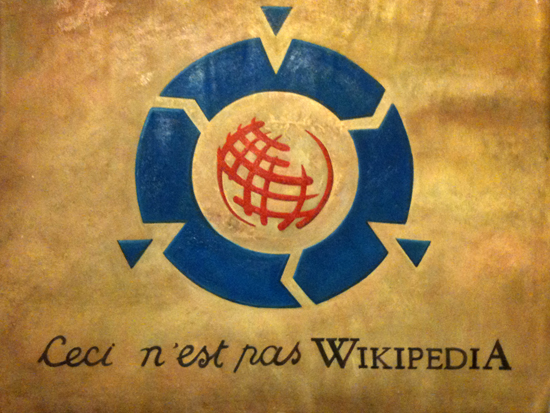
‘We ask our potential collaborators – online communities of bloggers, artists and instigators – to exploit the shortcomings of the Wiki through performance.’ Kildall and Stern
(Often unwitting) collaborators ‘performed’ the work through a debate about its aesthetic, conceptual and legal legitimacy in over 300 texts in over 15 languages on the Internet via blogs and forums such as Rhizome and Slashdot and in the press, including the Wall Street Journal and the Guardian UK.
This exhibition charts the inception, birth, life, death and resurrection of Wikipedia Art, which questions the authoritative role of Wikipedia. It reveals its fallibility whilst debating the control of access to and knowledge creation.
Wikipedia Art featured in the Internet Pavilion of the Venice Biennale 2009. In 2011 it was an awarded finalist at the Transmediale festival in Berlin.
Given Time by Nathaniel Stern
Furtherfield presents Stern’s polar projections of Second Life lovers. Second life is a 3D simulated and virtual world inhabited daily by thousands of people around the globe. To access Second Life, you must embody an avatar (a virtual human representation of yourself), seeing what they see through a computer screen. Stern places his lovers and us in a feedback loop between virtual and actual space.

In Given Time, two life-sized and hand-drawn avatars simultaneously stare longingly across their virtual pond and the real-world gallery floor. They hover in mid-air, almost completely still, supported by the gentle sounds of their breath, the wind blowing, and birds in the far-off distance. The viewer is both the observer and participant of this reciprocal relationship. Through the bodies and eyes of another, we see, look and are seen. Stern says: “Here, an intimate exchange between dual, virtual bodies is transformed into a public meditation on human relationships, bodily mortality, and time’s inevitable flow.”
Given Time was partly supported by the University of Wisconsin – Milwaukee and produced with the help of Jo-Anne Green and Bryan Cera.
Playing Duchamp by Scott Kildall
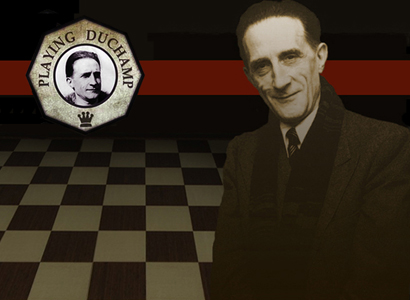
The American artist Scott Kildall, exhibiting for the first time in the UK, has fused the two worlds of art and chess in a homage to Marcel Duchamp, a chess master and artist recognised for shifting the paradigm of conceptual art. Using the recorded matches of Duchamp’s 72 tournament games, Kildall has modified an open-source chess engine to play chess as if it were Marcel Duchamp. By sitting down to this game of computer chess, visitors interact with the ghost of Marcel Duchamp, whose love for chess rivalled his attraction to art. Playing Duchamp is a 2010 New Radio and Performing Arts, Inc. commission for its Turbulence website.
Furtherfield invites you to come and play because, as Duchamp said: “The creative act is not performed by the artists alone”.
Playing Duchamp is a 2010 New Radio and Performing Arts, Inc. commission for its Turbulence website.
Going the distance for fine dining with global friends
In June, Furtherfield will host two telematic dinner parties to accompany this exhibition to create a co-presence dining experience with our remote friends mediated by digital technologies (network connections, projections, laptops and sonified objects). As food is the greatest mediator, we aspire to a satisfying remote connection through the frame of the dining experience.
Contact ale[at]furtherfield[dot]org for details on becoming a dinner guest.
Scott Kildall
Scott Kildall is a cross-disciplinary artist working with video, installation, prints, sculpture and performance. He gathers material from the public realm to perform interventions into various concepts of space.
Scott has a Bachelor of Arts in Political Philosophy from Brown University and a Master of Fine Arts from the School of the Art Institute of Chicago through the Art & Technology Studies Department. He has exhibited his work internationally in galleries and museums and received fellowships, awards and residencies from organisations, including the Kala Art Institute, The Banff Centre for the Arts, Turbulence.org and Eyebeam Art + Technology Center.
Scott is a founding member of Second Front — Second Life’s first performance art group. He is an artist-in-residence at Recology San Francisco. He currently resides in San Francisco.
More information: www.kildall.com
Nathaniel Stern
Nathaniel Stern (USA / South Africa) is an experimental installation and video artist, net.artist, printmaker and writer. He has produced and collaborated on projects ranging from interactive and immersive environments, mixed reality art and multimedia physical theatre performances to digital and traditional printmaking, concrete sculpture and slam poetry.
Nathaniel has held solo exhibitions at the Johannesburg Art Gallery, Johnson Museum of Art, Museum of Wisconsin Art, University of the Witwatersrand, University of Wisconsin-Milwaukee, and several commercial and experimental galleries throughout the US, South Africa and Europe. His work has been shown internationally at festivals, galleries and museums, including the Venice Biennale, Sydney Museum of Contemporary Art, International Symposium for Electronic Art, Transmediale, South African National Gallery, International Print Center New York, Milwaukee Art Museum and more. He is an Assistant Professor in the Department of Art and Design at the University of Wisconsin – Milwaukee.
More information: http://nathanielstern.com
Download Wikipedia Art: Citation as Performative Act (Creative Commons licensed)
by Scott Kildall and Nathaniel Stern, to be included as a chapter in ’ Wikipedia: Critical Point of View. Eds. Geert Lovink and Nathaniel Tkacz. Amsterdam: Institute of Network Cultures (University of Amsterdam), 2011. Forthcoming. Print.
Furtherfield, Unit A2, Arena Design Centre, 71 Ashfield Rd, London N4 1NY, +44 (0) 2088022827
Free admission to exhibitions and events -contact Alessandra Scapin ale[at]furtherfield[dot]org
TO BOOK YOUR PLACE NOW please email ale[at]furtherfield[dot]org
Over the last decade the awareness of anthropogenic climate change has emerged in parallel with global digital communication networks. In the context of environmental and economic collapse people around the world are seeking alternative visions of prosperity and sustainable ways of living.
While the legacy of the carbon fuelled Industrial Revolution plays itself out, we find ourselves grappling with questions about the future implications of fast-evolving global digital infrastructure. By their very nature the new tools, networks and behaviours of productivity, exchange and cooperation between humans and machines grow and develop at an accelerated rate.
The ideas for this transdisciplinary panel have grown out of Furtherfield’s Media Art Ecologies programme and will explore the impact of digital culture on climate change, developing themes adopted in grass-roots, emerging and established practices in art, design and science. The discussion will inform a second event in September at ISEA 2011 where we will be joined by artists Tom Corby and Helen Varley Jamieson.
Chair: John Hartley
Speakers: –
Michel Bauwens – On how Peer to Peer thought and technology point towards alternative production methods and a sustainable future.
Catherine Bottrill – On working with producers and consumers to consider the environmental long-tail of digital culture.
Ruth Catlow – On ecological approaches to tools, networks and behaviours in a digital art community.
Who this is for: any interested members of the public, cross-disciplinary (science, art, technology) practitioners, academics, students, researchers with an interest in digital culture, technology, sustainability.
Where: CREAM (Centre for Research in Education Art and Media), University of Westminster
Building: 309 Regent Street Campus
Room: RS 152 Cayley Room
Date/ Time: Friday May 13, 2011 from 6:00pm to 8:00pm
Maximum Seats: 60
Catherine Bottrill – Associate Director, Research Julie’s Bicycle
Catherine’s PhD research at the University of Surrey is studying the response of the UK Music Industry to climate change. The research is examining the efforts of the industry to organise itself to collectively take action to reduce greenhouse gas emissions. The study is exploring the possible opportunities, limitations and contradictions for the industry to support a cultural shift towards sustainable energy lifestyles. The research investigates the perspectives of music businesses, artists and audience.
Michel Bauwens – Founder of The Foundation for Peer 2 Peer Alternatives
Michel works in collaboration with a global group of researchers in the exploration of peer production, governance, and property. He has been an analyst for the United States Information Agency, knowledge manager for British Petroleum (where he created one of the first virtual information centers), eBusiness Strategy Manager for Belgacom, as well as an internet entrepreneur in his home country of Belgium.
Ruth Catlow – Co-founder and Co-director of Furtherfield
Ruth is an artist, curator and educator. As co-founder and co-director of Furtherfield.org a grass roots media arts organisation and its gallery (formerly HTTP) in North London, she works at the intersection of art, technology and social change with artists, curators, musicians, programmers, writers, activists and thinkers from around the world. She is currently developing the artistic programme and organisational infrastructure with a focus on Media Art Ecologies, aspiring to engender shared visions and infrastructures for other possible worlds. Ruth is Course manager for digital art and design degrees at Writtle School of Design, where she is currently developing a new BA and MA in Fine Art and Environment.
John Hartley – Art and Ecology Strategist
In his recent role as Arts Council England’s Arts and Ecology Strategy Officer, John supported the development of practice and infrastructure in the face of changing contexts. Also on the Arts Council’s Arts and Ecology partnership with RSA, on the GLA steering group for Greening London’s Theatres and the DCMS Climate Change Project. John led on developing ACE’s self-assessment toolkit to help arts organizations implement effective energy management programs. Implementation of the program can reduce energy usage and carbon emissions, potentially reducing energy costs by up to 20%. He is now a free-lance consultant, also a practicing artist, directs a collaborative experimental music group and has co-written a book published by Transworld.
Re-rooting digital culture is part of Furtherfield’s Media Art Ecologies Programme. This unconference event is partnered by CREAM (Centre for Research in Education Art and Media)
Italian artist duo Art is Open Source (AOS) will be working as Artists in Residence at Furtherfield Gallery and lab space in February 2011. During the four week residency Salvatore and Oriana will work on the development of their latest project REFF: the invasion of ordinary reality to reinvent a new one using a fake institution, a book, an urban performance and an augmented reality drug.
The residency will result in a final exhibition, REFF – REMIX THE WORLD! REINVENT REALITY!, showcasing a live, glitch performance, an urban intervention and a virtual entity by artists featured in the new REFF book: Garrett Lynch (Ir), Rebar Group (US) and xname (It) alongside a real-time interactive map that describes the life of REFF all over the world: 60 authors, artists, designers, architects, hackers, journalists, activists; dozens of actions; a live and real-time stream of information collectively produced by a worldwide community of re-inventors.
In the three weeks prior to the exhibition opening AOS will run workshops with students to use the augmented reality application. The students’ interventions will form part of the urban performances which will populate the gallery during the 4 week exhibition.
”The use of communication technologies and invasive practices for the reinvention of reality is crucial for student movements in this difficult moment. We would like to get the students involved in the REFF experiments by providing them with access to those technologies that can work as effective forms of critical and alternative communication. Students in UK and in Italy will have access to all the cross-medial CMS used to build the REFF book which will
enable them to create their own QRCodes and Fiducial markers that they can then stick around the city to disseminate information integrated within their communication across the web and the city.” – Art is Open Source
More information about the exhibition and workshops
For more about Art is Open Source and Fake Press:
www.romaeuropa.org
www.fakepress.it
www.artisopensource.net
Events related to this residency:
REFF – REMIX THE WORLD! REINVENT REALITY! at Furtherfield Gallery, 25 February – 26 March 2011.
REFF – REMIX THE WORLD! REINVENT REALITY! Opening Event at Furtherfield Gallery, 25 February 2011, 6:30-9pm
Furtherfield is pleased to present the UK Book launch of STATION ROSE: 20 Digital Years Plus, published by Verlag für Moderne Kunst Nürnberg.
DR. Richard Barbrook will give a short introduction to the evening.
The Digital Art of Station Rose started in Vienna in 1988, at a time when the Web still was far beyond mainstream, when Mondo 2000 never had heard about the music genre “Techno”, when future net-art-critics still mostly were university students, and when the Iron Curtain was surrounding Austria´s east, south east and north border.
“Station Rose had every right to claim ‘cyberspace is our land.’ They were there very early, they raised their antennas and put down deep roots, and they never left.” – Bruce Sterling, 2010
Station Rose, pioneers of digital culture, have produced an artist’s book which delivers a current description of the situation of media art from 1988, when the studio was founded, until 2010. Station Rose (Elisa Rose and Gary Danner) are considered to be innovators and visionaries in the field of audiovisual art, electronic music, net art and audiovisual live performance. The book features audio-visual works, performances, installations and Web 2.0 activities and linkings. Part of the book is dedicated to the media sculpture LoginCabin exhibited for three months in 2009 in the MAK in Vienna.
The latest art of Station Rose refracts the logistics and glitches of the Internet through the deceptively low-fi aesthetic of contemporary art’s installations and performances. “Twenty Digital Years Plus” shows how this fits into their history of using the viruses of visual, verbal and computer language to find insightful ways of conceptualising digital culture.
RSVP – Please contact Ale Scapin
http://www.stationrose.com/STR-Books/20DYplus-book.html
http://www.furtherfield.org/contact
Station Rose 20 Digital Years plus. 1988–2010 –>
paperbook with flaps 16,5 x 22 cm
192 pages., german/engl.
Euro 40,00/sFr 64,00
ISBN 978-3-86984-111-3
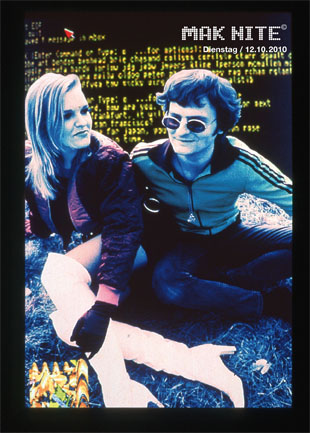
Peter Noever (preface), Howard Rheingold, Bruce Sterling, Gabriele Horn, Vitus H.Weh, Didi Neidhart, Peter Weibel, Dr.Hans Diebner, Christoph Tannert, David Hudson, Terence McKenna, Elisabeth Zimmermann, Doug Millison, Dr.Timothy Leary, Elisa Rose, STR, u. a.
Österreichisches Kulturforum Berlin, Stadt Frankfurt am Main – Dezernat für Kultur und Wissenschaft, BMUKK Wien, Hessisches Ministerium für Wissenschaft und Kunst, Kultur Land Oberösterreich.
Distributed in the United Kingdom
Cornerhouse Publications
70 Oxford Street, Manchester M1 5 NH, UK
phone +44-161-200 15 04, fax +44-161-200 15 04
Distributed outside Europe
D.A.P. Distributed Art Publishers, Inc.
155 Sixth Avenue, 2nd Floor, New York, NY 10013, USA
phone +1-212-627 19 99, fax +1-212-627 94 84
Private View: Friday 25 February, 6.30-9 pm with Live Performance by Garrett Lynch
Special guests on the night: Dr Richard Barbrook, Andy Cameron, Garrett Lynch, Quayola, and Eleonora Oreggia, aka XNAME.
REFF- Remix the World, Reinvent Reality! from Furtherfield on Vimeo.
Directly from Italy, Art is Open Source, and FakePress presents REFF a Fake Cultural Institution to launch, promote and distribute its Augmented Reality (AR) Drug to reinvent reality. Visit the exhibition to discover the effects of three innovative molecules created by the REFF chemical lab: REMIXine, REINVENTum, and REALITene.
REMIXINE
The REMIXine compound is an innovative molecule that forms a fundamental ingredient in all our drugs. The molecule powerfully reacts with others, disconnecting their predetermined bonds and allowing the core elements of other compounds to reassemble, forming entirely new ones in complete freedom. REMIXine augments the total entropy of systems, and it is a known stimulator of creative processes acting for the systematic creation of insights into the world.
REINVENTUM
REINVENTum compounds collaborate with the other molecules found in our drugs to reassemble components into new forms once their bonds have been disassembled. REINVENTum affects the equilibrium of neural ecosystems, as it can effectively activate the neurotransmitters which control human forms of expression: this action has profound impacts on the areas of the brain that engage language and memory, allowing the rapid formation of entire networks of new symbols.
REALITene
REALITene is an unstable compound. Its complex molecule self-arranges into virtually infinite configurations. Furthermore, different patients have been known to react to different molecule configurations at different times in their clinical life.
Also, explore MACME, the new open publishing tool at the exhibition, encounter the artworks and performances, and enjoy the freedom of access and expression. In other words…take the REFF AR Drug.
This exhibition showcases a live glitch performance, an urban intervention and a virtual entity by artists featured in the new REFF book: Garrett Lynch (Ir), Rebar Group (US) and xname (It) alongside a real-time interactive map that describes the life of REFF all over the world: 60 authors, artists, designers, architects, hackers, journalists, activists; dozens of actions; a live and real-time stream of information collectively produced by a worldwide community of re-inventors.
The REFF map on the exhibition is available online from the opening date: http://reff.romaeuropa.org. The mapping process is open: please contact us if you feel that your actions are reinventing reality and, thus, should be added to the visualization.
For more about Art is Open Source and Fake Press
www.romaeuropa.org
www.fakepress.it
www.artisopensource.net
Trav–erse – Live performance by Garrett Lynch
Exploring radio waves on a world band analogue radio, the performance should be perceived as both a linear and non-linear journey progressively moving through the sonic space of broadcast wireless networks and the physical geographies and cultural spaces they both represent and permeate.
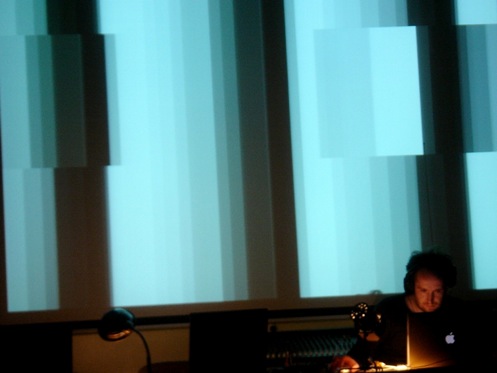
The performance traverses and returns across a radio band, a technological interface, along linear trajectories. Sounds with no correlation between their representation on this band and their ‘actual’ location will be captured, layered, reworked, and transformed within new media to create a cultural and social sonic dérive where all spaces exist simultaneously.
Garrett Lynch (IRL) is an artist, lecturer, curator and theorist. His work deals with networks (in their most open sense) within an artistic context; the spaces between the artist, artworks and audience as a means, site and context for artistic initiation, creation and discourse. Recently most active in live performance, Garrett’s practice covers net.art, installation, performance and writing.
PARKcycle by Rebar Group
The PARKcycle is a human-powered open space distribution system designed for agile movement within the existing auto-centric urban infrastructure.
While its physical dimensions synchronize with the automotive “softscape” of lane stripes and metered stalls, the PARKcycle effectively re-programs the urban hardscape by delivering massive quantities of green open space—up to 4,320 square foot minutes of park per stop—thus temporarily reframing the right-of-way as green space, not just a car space.
Using a plug-and-play approach, the PARKcycle provides open space benefits to neighbourhoods that need it, when they need it, as soon as it is parked.
Built-in collaboration with the kinetic sculptor Ruben Margolin at his studio in Emeryville, California, the PARKcycle made its debut on PARK(ing) Day 2007 in San Francisco.
PARKcycle was made possible by a grant from the Black Rock Arts Foundation.

REBAR is an interdisciplinary art and design studio based in San Francisco. Rebar has created public art interventions and design projects around the globe. Rebar remixes the ordinary repurposes the ubiquitous, and restructures the fabric of the urban environment by exposing hidden assumptions and shared meanings embedded in the everyday experience of the built world.
Virtual Entity by XNAME
Virtual Entity is a research project and net-art work trying to redefine the concepts of authenticity, ownership, uniqueness and seriality within the digital domain. The practical aspect of this speculation is a simple application developed to create (and edit) the soul of a file. This is a metaphor: the soul, a text-based soul, is the place where it is written who or what a certain entity is; it is a mark for preserving identity.
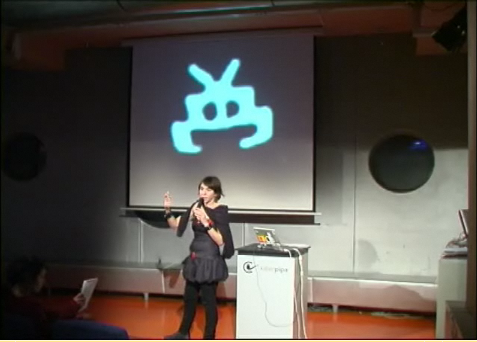
This software, proposing a single answer to the questions raised by the practices of licensing and cataloguing digital files, is transforming the traditional approach towards metadata and digital property. The main idea is that any file is an independent creation living its own life and experiencing various levels of transformation and progressive generation (of meaning, shape, and entities) in the course of its virtual existence. The main focus points are the relations (semantic or genetic) among files and the processes of fragmentation, multiplication and transmutation of the cultural units composing them.
Virtual Entity constructs in parallel a theoretical mythical world and its functional technical counterpart; its ultimate shape (and visualization) is that of a monster, a bodyless entity composed of souls and formed by the structure of their relations – and the history of digital data starts drawing itself.
Virtual Entity is displayed for the first time as an installation at Furtherfield Gallery in London. The work takes the form of a tryptic. The central projection shows the command line application soul, the left monitor displays the web application souls, while the right monitor displays the virtual entity monster, a real-time representation of the database performed by live coding software Fluxus.
Virtual Entity Alpha is prototype software. Its main new features are URL support, macosx install, web application, Fluxus visualisation. This software was designed by xname and coded by xname, megabug, Antonios Galanopoulos and Gabor Papp.
Events at Furtherfield Gallery
Opening event: 25 February 2011, 6.30-9pm
Live Performance by Garrett Lynch at 7.30pm
Special programme by REFF the Fake Institution
Open call to Remix the World! Reinvent Reality
The REFF map on the exhibition is available online from the opening date: http://reff.romaeuropa.org. The mapping process is open: please contact us if you feel that your actions are reinventing reality and, thus, should be added to the visualization. http://www.furtherfield.org/contact
REFF Youth Programme
A special task force was required to ensure the immediate diffusion of the REFF AR Drug to the younger generations. Perhaps surprisingly, the Fake Institution agenda has inspired approval and enthusiasm in the academic world. In the two weeks before the exhibition FakePress, together with Art is Open Source, is running a series of workshops and presentations across universities and to groups of students in and around London to remix the world: Southbank University, Goldsmiths, Writtle College, University of Westminster, Queen Mary University.
Please contact us if you’d like to participate or organise further workshops/presentations http://www.furtherfield.org/contact
More information about student workshops.
Please visit AOS website to learn more about what happened during the REFF workshops
MACME, an open source tool for cross-medial publishing
Created by FakePress, MACME is new a cross-media, multi-author content management system, that enables the creation of multi-device and paper publications, featuring location- based technologies, QR-codes, and augmented reality .
The platform will be released for the first time during the days of the exhibition, under a GPL3 Licence, as a real policy for access promoted by the REFF.
Student movements in Italy/UK
”The use of communication technologies and invasive practices for reinvention reality is crucial for student movements in this difficult moment. We would like to get the students involved in the REFF experiments by providing access to those technologies that can work as effective forms of critical and alternative communication. Students in the UK and in Italy will have access to all the cross-medial CMS used to build the REFF book, which will enable them to create their own QRCodes and Fiducial markers that they can then stick around the city to disseminate information integrated within their communication across the web and the city.” – Art is Open Source.
During the exhibition run, students will also be invited to curate their own event in which they can present their take on the idea of “reinvention of reality”, and connect with the students’ movements in other countries (using Skype at Furtherfield, at the ESC in Rome and at the Cantiere in Milan) presenting themselves to each other. The event will terminate with an urban performance in which each party exchanges and prints QRCodes stickers that are then disseminated across the city.
More about Art is Open Source
AOS operates interdisciplinarily across universities and research institutes, businesses and associations, critical collectives and extreme practitioners in arts and design, promoting innovative approaches to the environment, to (multi)cultural interaction, and to the creation of real, sustainable and socially responsible opportunities.
More about REFF
REFF started by investigating themes around intellectual property and cultural policies and then expanded to the domains of freedom of expression and the idea that the tactical use of technologies and network-oriented practices can enable people to change the rules of the game and reinvent our reality. Taking inspiration from street arts, raves, skateboarding, and technologies allow us to re-code and write onto the world, creating layers of additional reality that express our own interpretation of the cities we live in, of the things we buy and use every day.
One project outcome is a book published in 2010, which will soon be available in English. The book is a cross-medial publication enacting the theories investigated by FakePress (a next-step publishing house created by AOS in 2009 researching the REFF themes through the idea of reinventing publishing itself): it is simultaneously a book; a location-based, augmented reality application; a living digital ecosystem; and a wide tagging mechanism using QRCodes and Fiducial Markers to disseminate content and interactions on objects, architectures and spaces.
The book was created using a series of technological tools to maximise accessibility to these critical tactical technologies. The tools have been arranged into a platform called MACME (Multi Author Cross Medial Ecosystem) that has just been released under a GPL3 licensing scheme. The release of these and further technologies is an integral part of the work of net.art, which informs the REFF project.
For more information:
http://www.artisopensource.net
http://www.romaeuropa.org/
http://www.fakepress.it/
HTTP Gallery is pleased to host the UK premiere of In the Long Run (2010), the new work by art collective IOCOSE, produced by Aksioma – Institute for Contemporary Art (Ljubljana) as part of the platform RE:akt!.
View short Trailer of video on Youtube
In the Long Run (2010) is a reconstruction of a possible future high profile media event. The death of pop star Madonna is described in a BBC News special edition, with a journalist and studio guest who go over the details of the fatal car accident, the statements of the VIPs and the reactions of fans around the world.
It is not a true story, but neither is it improbable. All TV networks prepare obituaries about famous people to put on air in the event of an unexpected death. The death of an international figure is not just predictable, it is actually predicted in the video files kept up to date in their archives.
The new video will be accompanied by two previous works, Doughboys (2009), a ‘real time mockumentary’, following a trio of real-life super heroes who defended illegal issues in the police patrolled streets of Rome, and FloppyTrip (2009), an installation consisting in a kit, to prepare your own hallucinogenic drink by recycling redundant floppy disks and provided with a video explaining how to use it.
IOCOSE has been working in Italy and Europe since 2006. It organises actions in order to subvert ideologies, practices and processes of identification and production of meanings. It uses pranks and hoaxes as tactical means, as joyful and sound tools. IOCOSE thinks about the streets, Internet and word of mouth as a battlefield. Tactics such as mimesis and trickery are used to lead and delude the audience into a semantic pitfall.
IOCOSE will be interviewed live on Furtherfield on Resonance FM on Wednesday 03 November at 7pm. Available to download from www.furtherfield.org/resonancefm.php
To accompany In the Long Run, we are pleased to present a new essay by critic, writer and curator Domenico Quaranta about IOCOSE’s new work. (download PDF)
Production: Aksioma – Institute for Contemporary Art, Ljubljana, 2010 www.Aksioma.org Project produced as part of the platform RE:akt!
Also screening at:
RE:akt! – Reconstruction, Re-enactment, Re-reporting
Rotovz Exhibition Salon, Maribor, Slovenia
21 October – 19 November 2010
More Information:
IOCOSE: www.iocose.org
RE:akt!: www.reakt.org
HTTP Gallery is pleased to host LAB4 by Hedva Eltanani, an exploration of communication between two places using streaming media and web applications. It is another step in a series of LABs that explore digital technology and audience interaction. It is part of Heltanani’s research on digital performance and the way it affects audience experience.
LAB4 is a game that challenges the audience to bend the boundaries of space, interaction and intimacy. The two locations, HTTP Gallery in London and The Poly Centre in Falmouth, are linked via live-feed technology, using webcams and web applications. Eltanani will lead a series of activities, such as ‘truth or dare’, which challenges elements of group dynamics and technology – the aim is to engage the two audiences and help participants bond within each group.
How intimate will it go? The participants are invited to deepen the connection by keeping their community active using web applications.
BE PART OF THE EVENT IN LONDON
Doors open at 8:30pm
More info and documentation :
http://arthubfalmouth.blogspot.com/
http://vs4rslab.wordpress.com/
Featured image: People watching and being watched across virtual space
Alejo Duque, Kathrin Guenter, Graham Harwood, Martin Howse, Petr Kazil, Jonathan Kemp, Martin Kuentz, Tom McCarthy, Christian Nold, Nick Papadimitriou (tbc), John Rogers (tbc), Karen Russo, Gordan Savicic, Suzanne Treister, Danja Vasiliev, Ryan Jordan
Helen Varley Jamieson and Paula Crutchlow will be working as Artists in Residence at HTTP, Furtherfield’s Gallery and lab space in July 2010. During this residency Helen and Paula will work on their make-shift project.
Events related to this residency:
make-shift presentation by the artists at HTTP Gallery, 22 July 2010.
More information about this work in progress presentation.
“make-shift is an intimate and participatory performance event that explores the fragile connectivity of human and ecological relationships. Part recital, part discursive salon the performance uses online audio-visual conferencing, chat and performance tools to connect two ordinary living-rooms and their audiences across geographical and cultural distance.”
http://make-shift.net/
Helen Varley Jamieson is a writer, theatre practitioner and digital artist from New Zealand. In 2008 she completed a Master of Arts (research) at Queensland University of Technology (Australia) investigating her practice of cyberformance – live performance on the internet – which she has been developing for over a decade. She is a founding member of the globally-dispersed cyberformance troupe Avatar Body Collision, and the project manager of UpStage, an open source web-based platform for cyberformance. Using UpStage, she has co-curated online festivals involving artists and audiences around the world. Helen is also the “web queen” of the Magdalena Project, an international network of women in contemporary theatre.
www.creative-catalyst.com
Paula Crutchlow lives with her family in Exeter, Devon. She graduated in Dance from De Montfort University, and in 2000 completed an MA in Devised Theatre at Dartington College of Arts, UK where she is now an Associate Lecturer in Theatre. Paula has worked in Britain and internationally as a performer, director and tutor of movement and devised theatre. As a co-founder and Artistic Director of Blind Ditch she has collaborated on context-specific collaborative art, performance and cultural events which engage audiences and participants in distinct ways through the use of digital media and live performance.
www.blindditch.org
>> make-shift work in progress presentation by Helen Varley Jamieson and Paula Crutchlow
Thursday 22nd July 7pm
HTTP Gallery
RSVP: brokers@make-shift.net
You are invited to attend and actively contribute to a work in process sharing of make-shift – a networked performance about connectivity and consequences.
Helen Varley Jamieson (NZ/Europe) and Paula Crutchlow (UK) are artists from different performance backgrounds whose new collaboration, make-shift, explores meaningful ways of engaging in discussion across physical and digital networks. make-shift will be a salon-style event, taking place simultaneously in two domestic spaces (with one artist present in each space) and also online.
The process of making make-shift has begun with a two-week residency at Furtherfield.org, London, and in this presentation the artists would like to share some of their research and try out some ideas. You will be asked questions and invited to contribute your expertise, experience and opinions to this process. The artists are working in the spaces between disciplines and genres and are deliberately inviting people from a range fields to get a range of input. Your contribution to this will be very much valued.
You must RSVP (to brokers@make-shift.net) as the proximal audience is limited (there will also be the opportunity to participate online if you are not in London or can’t get to the event). Everyone who is attending is asked to collect their plastic rubbish over a 24 hour period and bring it to the presentation (please wash anything that had food in it!)
We also need two volunteers to prepare specific tasks before the event – please email brokers@make-shift.net if you would like to volunteer.
Ruth Catlow, Marc Garrett, Corrado Morgana
Come and celebrate with Furtherfield.org the recent publication of ‘Artists Re: Thinking Games’.
This is an unmissable event for all artists/gamers with a presentation by respected game artist Dr Mary Flanagan, a guest appearance by Jeremy Bailey and a display of some of the gameart featured in the book as well as an introduction by the editors.
Corrado Morgana – About the book.
Ruth Catlow & Marc Garrett – Extra Context.
Guest Speaker – Mary Flanagan.
Guest Appearance – Jeremy Bailey.
Food and drink will be served.
At Birkbeck University of London’s Cinema
43 Gordon Square
Birkbeck, University of London.
London WC1H 0PD
Time 2pm – 4.30pm
Thursday June 10th 2010.
RSVP – contact ruth.catlow@furtherfield.org
Editors Ruth Catlow, Marc Garrett, Corrado Morgana.
Digital games are important not only because of their cultural ubiquity or their sales figures but for what they can offer as a space for creative practice. Games are significant for what they embody; human computer interface, notions of agency, sociality, visualisation, cybernetics, representation, embodiment, activism, narrative and play. These and a whole host of other issues are significant not only to the game designer but also present in the work of the artist that thinks and rethinks games. Re-appropriated for activism, activation, commentary and critique within games and culture, artists have responded vigorously.
Over the last decade artists have taken the engines and culture of digital games as their tools and materials. In doing so their work has connected with hacker mentalities and a culture of critical mash-up, recalling Situationist practices of the 1950s and 60s and challenging and overturning expected practice.
This publication looks at how a selection of leading artists, designers and commentators have challenged the norms and expectations of both game and art worlds with both criticality and popular appeal. It explores themes adopted by the artist that thinks and rethinks games and includes essays, interviews and artists’ projects from Jeremy Bailey, Ruth Catlow, Heather Corcoran, Daphne Dragona, Mary Flanagan, Mathias Fuchs, Alex Galloway, Marc Garrett, Corrado Morgana, Anne-Marie Schleiner, David Surman, Tale of Tales, Bill Viola, and Emma Westecott.
In collaboration with FACT – http://www.fact.co.uk
http://www.furtherfield.org
http://www.http.uk.net/
Publisher: Liverpool University Press (31 Mar 2010)
Language English
ISBN-10: 1846312477
ISBN-13: 978-1846312472
http://www.amazon.co.uk/gp/offer-listing/1846312477
The Zero Dollar Laptop Project aims to change the way we all think about technology through a program of workshops, public debates, exhibitions, and networks of skills and media sharing for arts, technology and the environment.
View the Zero Dollar Laptop workshop blog for resources and news.
Workshops ran in London from January to April 2010 with clients of St Mungo’s charity for homeless people and we are currently developing workshops with groups of young people.
We are recycling hardware, breaking Windows and installing Free and Open Source Software to build media laptops and create music, graphics and video for distribution over the Internet. Participants leave the project with street-smart technical knowledge and a wireless enabled media laptop, classier than any shiny power-book.
The Zero Dollar Laptop is a recycled computer, running Free Open Source Software (FOSS) that is fast and effective- now and long into the future.
The Zero Dollar Laptop project is developed in partnership with Access Space in Sheffield, inspired by the Zero Dollar Laptop Manifesto as part of Furtherfield.org Media Art Ecologies
Artistic Team: Jake Harries and James Wallbank (Access Space) Ruth Catlow, Marc Garrett and Olga Panades (furtherfield.org)
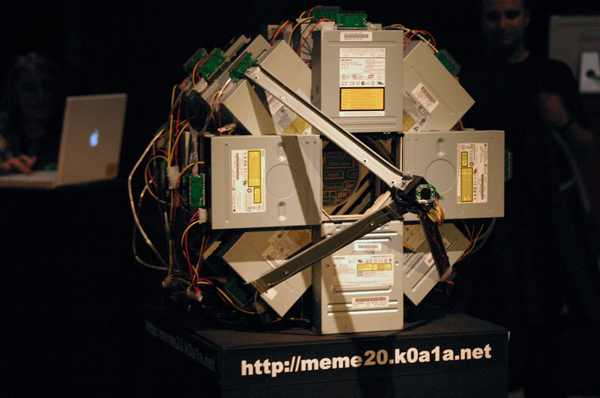
Danja Vasiliev will be working as an Artist in Residence at HTTP, Furtherfield’s Gallery and lab space in March 2010. During this residency Danja will work on his Netless project. Netless is an attempt to create a new network, alternative to the internet. More precisely – networks within existing city infrastructures, possibly interconnected into a larger network alike the internet. Netless is not dependent on specialized data carriers such as cables or regulated radio channels. In fact, there is no permanent connection between all of its hosts (peers) at all – it is net-less.

The network is based on the city transportation grid, where traffic of the vehicles is the data carrier. Borrowing the principals of the ‘sneaker-net’ concept, the information storage devices are physically moved from point A to point B. Numerous nodes of the netless network are attached to city buses and trams. Whenever those vehicles pass by one another a short range wireless communication session is established among the approaching nodes and the data they contain is synchronized. Spreading like a virus, from one node to another, the data is penetrating from the suburbs into the city and backwards, expanding all over the area in the meanwhile. The signal of any of netless nodes can be received and sent to using any wifi enabled device – a laptop, pda or mobile phone.
There are no addresses or routes in the netless network – any participant can potentially receive all data circulating in the network – all data is broadcast. Personal messages and datagrams can be sent using pgp-like personalized keys which ensure that only two people (the original sender and intended receiver) can decipher the message. Only such, as it might seem, oversimplified approach for communication allows the network to be completely homogeneous and flat – any node can be replaced by any other without any modification or configuration. In such an environment it is also impossible to trace data flows.
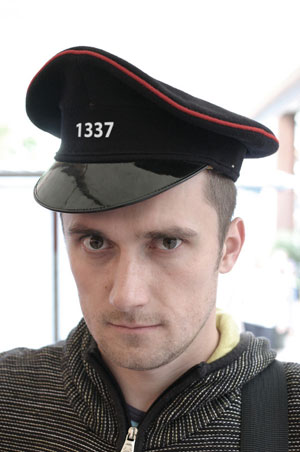
2006-2008: MA in Networked Media (Media Design) at Piet Zwart Institute, Netherlands
2006-2003: BA in ‘Media art’ AKI Academy of Visual Art and Design, Netherlands
2000-2001: Institute ‘ProArte’, short course of new media arts, Saint-Petersburg, Russia
1996-1999: Academy of Culture and Art, Media and Information Design, Saint-Petersburg, Russia
Danja Vasiliev is a co-founder of moddr_lab – http://moddr.net/.
DIWO At the Dark Mountain: A Mail-Art project across physical and digital networks in collaboration with the Dark Mountain Project; to question the stories that underpin our failing civilisation and to craft new ones for the age ahead.
Join us at full moon from 3 pm, Saturday 30th January 2010 for our closing event- to take apart and redistribute Mail-Art provoked by the Dark Mountain project.
• Take down the artworks and mail them back out into the world .
• Everyone who comes along gets to take an artwork away with them and to send artworks to friends and acquaintances.
This event is a celebration of the DIWO (Do It With Others) spirit, the collaborative process and excellent contributions from the artists who took part. As well as a chance to reflect on the ideas and controversies generated by The Dark Mountain Project, which provided the focus for the exhibition. There will be eating and drinking!
Visit here for images of the exhibition opening and performance
E-Mail: go to http://netbehaviour.org, subscribe to the NetBehaviour email list, correspond and join the explosive discussions in image, text, sound, movie and code.
Mail via Royal Mail: working with, or around, striking mail-workers, send chain letters, circular interviews, or invent some rules for Royal Mail object relay.
All outrages, gifts, offers , overtures and bids should arrive at HTTP Gallery by Thursday 26 November addressed to:
DIWO, HTTP Gallery,
Unit A2, Arena Design Centre,
71, Ashfield Road,
London, N4 1NY
England, UK
The Open Curation event: Friday 27 November 2009, 12-3pm to decide how to best display all submissions and entries at HTTP Gallery. Join us at the gallery or online by webcam, instant messaging and Skype. To learn how visit http://http.uk.net/diwodarkmountain
Follow the blog where Dark Mountaineer, Dougald Hine, will be your guide to the emerging landscape of email and snailmail exchanges.
Attend the Open Disassembly Event: 30 January 2010, 7-9pm Full Moon
Assemble at HTTP Gallery for the closing event to help us disassemble the display and to choose the work you would like to take home with you.
If not you not me is the first solo exhibition of Annie Abrahams’ work in the UK. While social networking sites make us think of communication as clean and transparent, Annie Abrahams creates an Internet of feeling – of agitation, collusion, ardour and apprehension. This exhibition presents three new collaborative works alongside documentation of recent networked performances created and curated by the artist.
Live feed of Shared Still Life / Nature Morte Partagée from SelfWorld during gallery opening times.
Read the article If not you not me, Annie Abrahams and life in networks, by Maria Chatzichristodoulou in Digimag 54 May 2010.
Annie Abrahams (b. NL 1954, lives and works FR) is an internationally regarded pioneer of networked performance art. If not you not me at HTTP Gallery in London is the first solo exhibition of her work in the UK. While social networking sites make us think of communication as clean and transparent, Annie Abrahams creates an Internet of feeling – of agitation, collusion, ardour and apprehension. This exhibition presents three new collaborative works alongside documentation of recent networked performances created and curated by the artist.
Working with simple interfaces, disruptions in data-flow and carefully crafted instructions, Abrahams sensitises participants and audiences to glitches in communication and invites them to experience and reflect on different ways of being together in a machine-mediated world. This exhibition asks how we deal with the tensions of collaboration and physical separation as we negotiate relationships through video imagery, computer software and digital networks.
Abrahams has created three new works for If not you not me, inviting collaboration from visitors to the HTTP Gallery and others around the world. Shared Still Life / Nature Morte Partagée, the central work in the exhibition, is a telematic still life for mixed media and LED message board. Visitors to HTTP Gallery are invited to communicate with those at Kawenga – territoires numériques a media arts space in Montpellier, France by arranging objects in the still life and sending messages to one another, with the results visible in a projection in both galleries. Two additional performances will take place during the opening on 12 February. On Collaboration Graffiti Wall, a collective text and speech performance, visitors will reiterate reflections on the nature and problems of online collaboration collected on a special website open to contributions. The resulting traces on the gallery wall will remain visible throughout the exhibition. Huis Clos / No Exit – Jam, a telematic performance projected at HTTP Gallery and in Kawenga – territoires numériques, will feature four women artists: Antye Greie (Hailuoto, FI), Pascale Gustin (Paris, FR), Helen Varley Jamieson (Wellington, NZ), and Maja Kalogera (Madrid, ES). Sitting before webcams in different locations around the world, they will try to organise a unified sound performance, despite the inevitable delays that result from the international live feed. Audio documentation of the performance will play in the exhibition.
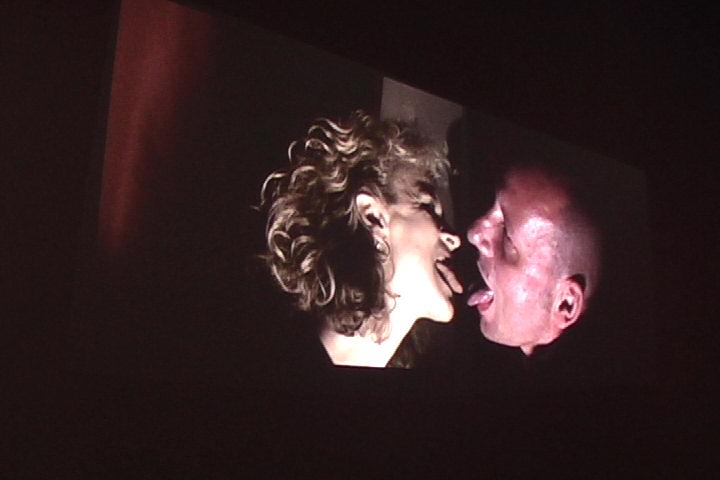
In addition to the new works, the exhibition presents documentation of live Internet video-streams from two ground-breaking networked performance series curated by Abrahams, Breaking Solitude and Double Bind, as well as Oppera Internettikka-Sécurité et protection, her collaboration with Slovenian artist Igor Stromajer, and her artistic research project Huis Clos / No Exit. Concerned with questions of co-existence and collaboration they include performances by influential artists working in the field including Helen Varley Jamieson (NZ), Robin Nicolas (BE) and Renée Turner (NL). The exhibition also includes performances by Abrahams with other international collaborators. Individual agency, controlling behaviours, intimacy and improvisation are the subjects of three extended performances questioning the ‘presence’ of the digital network: One the Puppet of the Other co-created with Nicolas Frespech (FR), Double Blind (Love) co-created with Curt Cloninger (US), and The Big Kiss featuring Mark River (US).
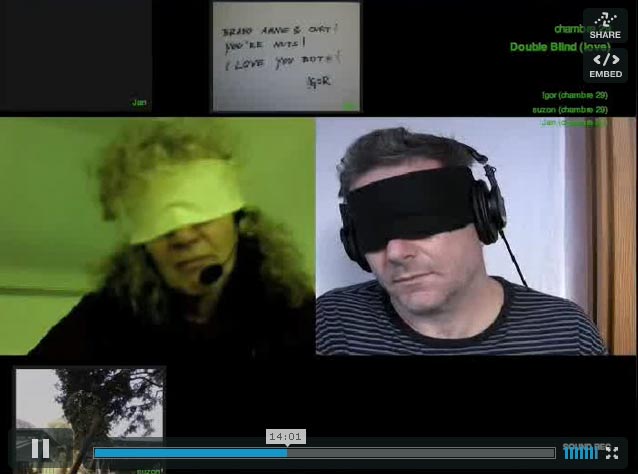
Annie Abrahams was born to a farming family in a rural village in the Netherlands. She obtained a doctorate in biology in 1978 and found that her observations of monkeys inspired curiosity about human interactions. After leaving an academic post, she trained as an artist and moved to France, where she became interested in using computers to construct and document her painting installations. She began experimenting with networked performance and making art for the Internet in the mid 1990s. Her work has since returned to the questions raised by the monkeys, concentrating on the possibilities and limitations of communication on the Internet. She has performed and shown work extensively in France, including at the Pompidou Centre, Paris, and in many international galleries including among others Espai d’Art Contemporani de Castelló, Spain; the Museum of Contemporary Art, Tokyo; and the Armenian Center for Contemporary Experimental Art, Yerevan; festivals such as the Moscow Film Festival and the International Film Festival of Rotterdam, and on online platforms such as Rhizome.org and Turbulence.
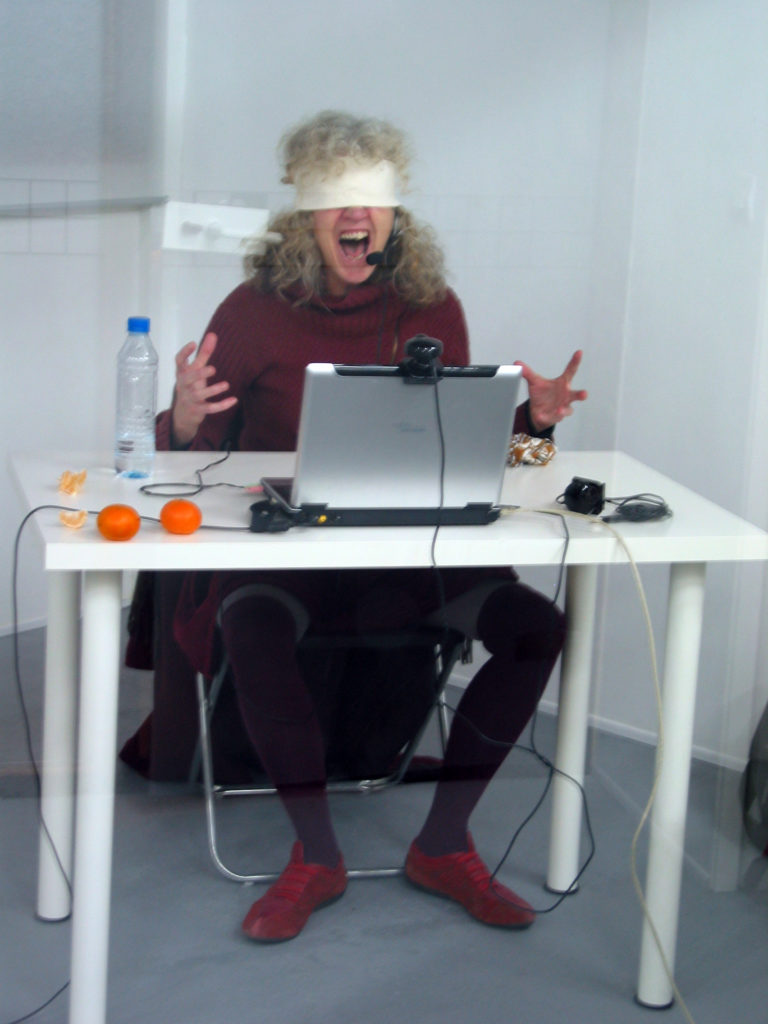
If not you not me is co-produced by Furtherfield.org and HTTP Gallery, London, and bram.org and Kawenga – territoires numériques, Montpellier, France. Furtherfield.org supports experimental practices at the intersections of art, technology and social change. This exhibition was conceived in connection with Furtherfield.org’s Rich Networking project interrogating the transparency of communication, artistic collaboration and sociability through digital networks. This is the fourth event in Furtherfield.org’s three-year Media Art Ecologies programme which foregrounds practices sharing an ecological approach – an interest in the interrelation of technological and natural processes: beings and things, individuals and multitudes, matter and patterns.
Private view and performances: Friday, 12 February 2010, 6:30-9pm, HTTP Gallery 7pm: On Collaboration Graffiti Wall – Collective text and speech performance at HTTP Gallery. To contribute or view texts to be used during the performance visit http://bram.org/collaboration/index.php 8pm: Shared Still Life / Nature Morte Partagée goes live – Telematic Still Life at HTTP Gallery and Kawenga – territoires numériques, Montpellier, France. 8:30pm: Huis Clos / No Exit – Jam – Telematic performance projected at HTTP Gallery, featuring Antye Greie (Hailuoto, FI), Pascale Gustin (Paris, FR), Helen Varley Jamieson (Wellington, NZ), and Maja Kalogera (Madrid, ES).
HTTP Gallery will be arranging special group visits simultaneous with visits to Kawenga – territoires numériques, which will allow interaction between the spaces through Shared Still Life / Nature Morte Partagée. To arrange a visit for a school or university group, please contact Ale Scapin at ale[AT]furtherfield[DOT]org.
Catalogue essay by Ruth Catlow on furtherfield.org
Annie Abrahams – http://aabrahams.wordpress.com
Bram.org – http://bram.org
Kawenga – territoires numériques – http://www.kawenga.org
Furtherfield.org’s Media Art Ecologies programme –
http://www.furtherfield.org/mediaartecologies.php
Review of the exhibition on Fabric Magazine
HTTP Gallery
Unit A2, Arena Design Centre
71 Ashfield Road
London N4 1N4
+44(0)77 3700 2879
Click here for map and location details